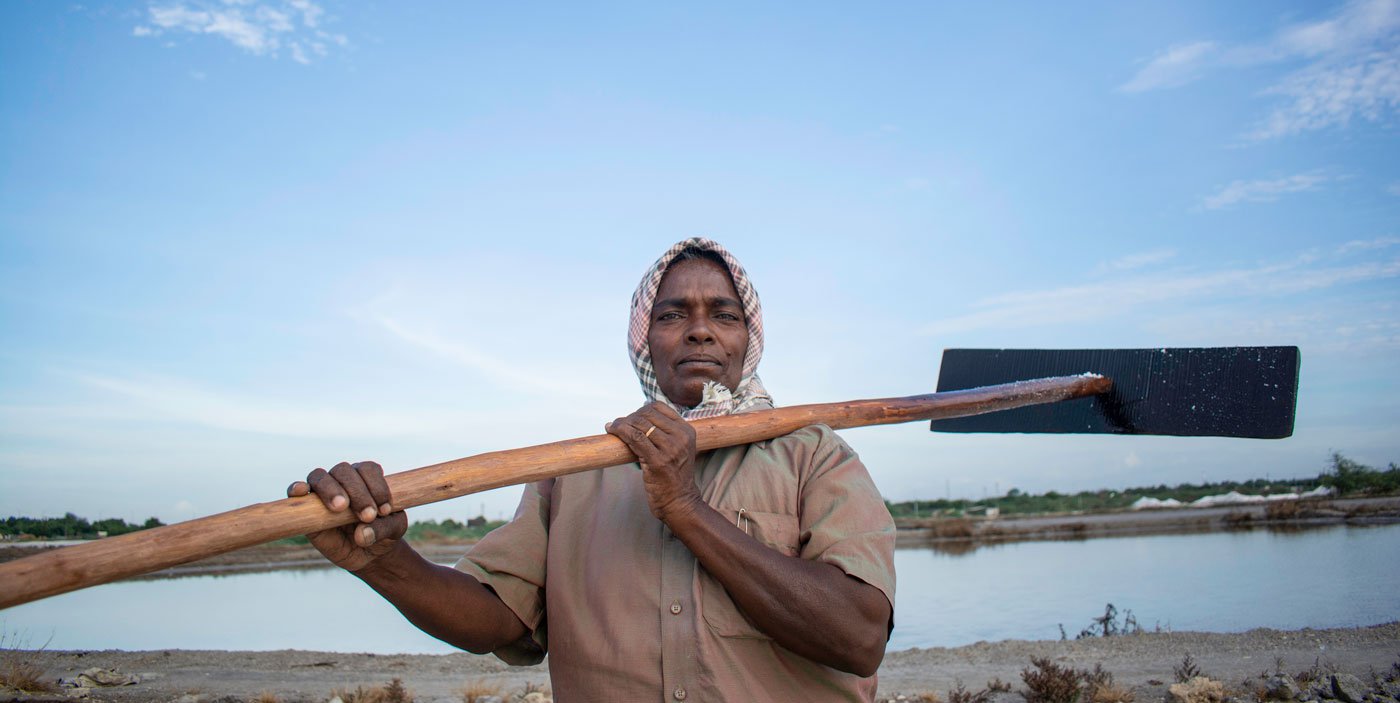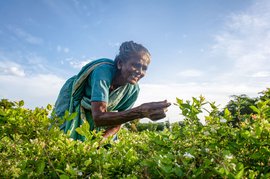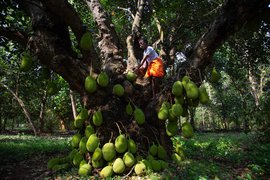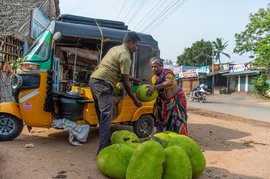Editor’s note: This is the first story of a series titled ‘Let Them Eat Rice’, on seven crops in Tamil Nadu. PARI will publish 21 multimedia reports in this series over two years, which will look at the lives of farmers through the universe of their crops. The series by Aparna Karthikeyan is supported by a grant from the Azim Premji University, Bengaluru.
As the sun rises over Thoothukudi – golden and beautiful – Rani is already at her workplace. With a long wooden paddle, she gathers the most common, yet most important of kitchen staples: salt.
Scraping the bottom of the rectangular plot she is working on, treading a surface now crunchy, now squelchy, she heaps the white crystals to one side. With each tiny but tiring trip to the space where she is piling it all up, the crystal mound grows higher, her work gets harder. Because each time she does this, the 60-year-old is dragging and adding to the mound over 10 kilograms of wet salt – a little under a fourth of her own body weight.
And she works without a break until the 120x 40-foot plot is just a watery reflection of the pale morning sky and her own moving shadow. This salty world has been her workplace for 52 years, as it was her father’s before her and is now her son’s. It is here that S. Rani tells me her story. And that of the 25,000 acres of salt pans in Thoothukudi district of southern Tamil Nadu.
From March to mid-October, this coastal district is perfectly suited to manufacture salt as it is hot and dry, guaranteeing over six continuous months of production. It is the largest producer in Tamil Nadu, and the state itself accounts for 2.4 million tons or roughly 11 per cent of India’s salt. The greatest share though comes from Gujarat, home to over 16 million tons, or 76 per cent of the country’s annual average salt harvest of 22 million tonnes. That national figure is itself a huge leap from the 1.9 million tons the country produced in 1947.
It’s mid-September 2021 and this is PARI’s first visit to the salt pans near Raja Pandi Nagar in Thoothukudi. Rani and her co-workers meet us in the evening for a chat, seated on a circle of chairs under a neem tree. Their houses, some with brick walls and asbestos roofs, others just huts with their thatches collapsing, lie behind us. The ‘salterns’ or areas where salt is made, are right across the road – their workplace for generations. The light is fading as the conversation begins. A chat that becomes a class, a rapid education, on the complex process of manufacturing sodium chloride (NaCl), the chemical name for salt.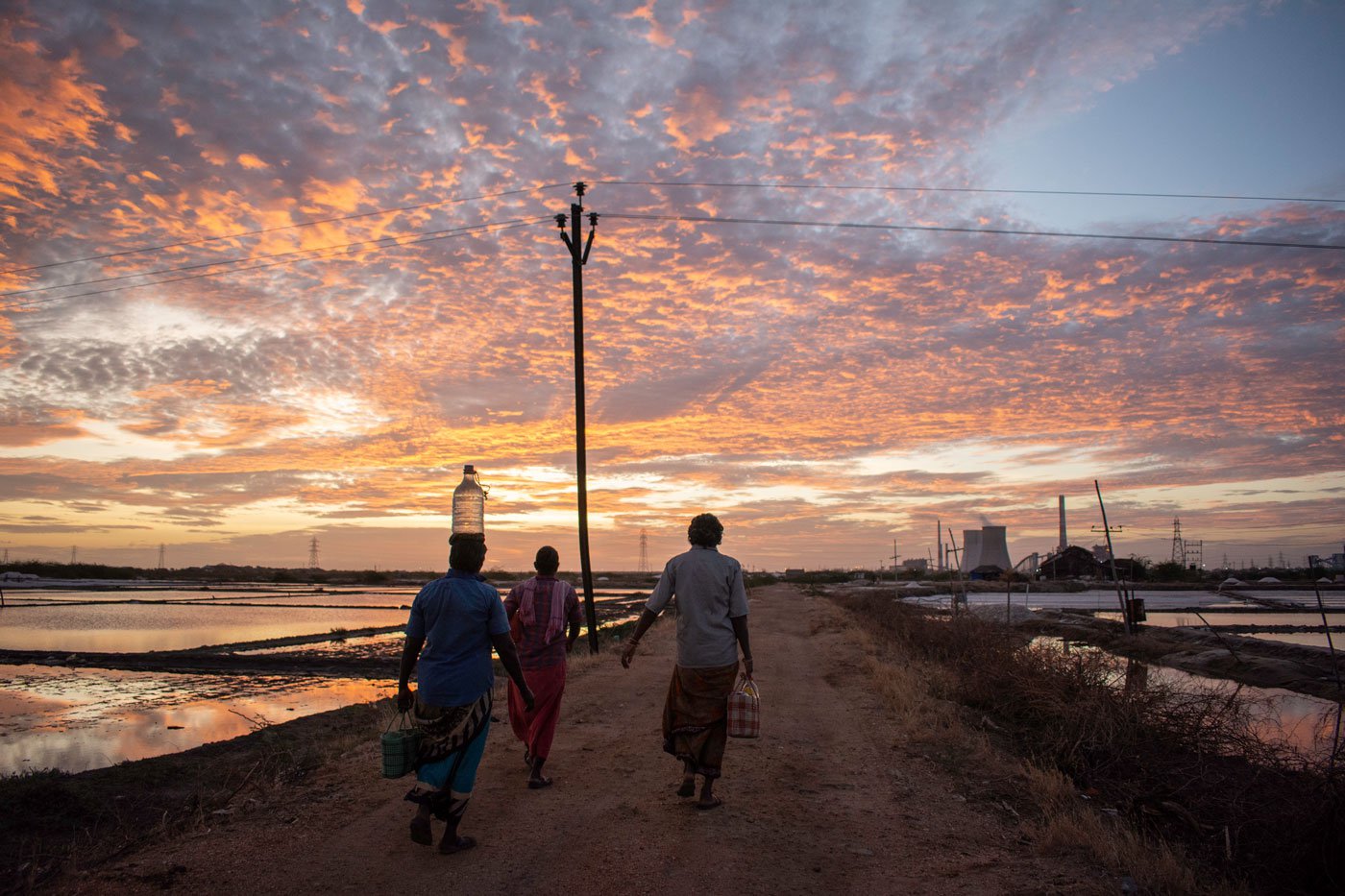
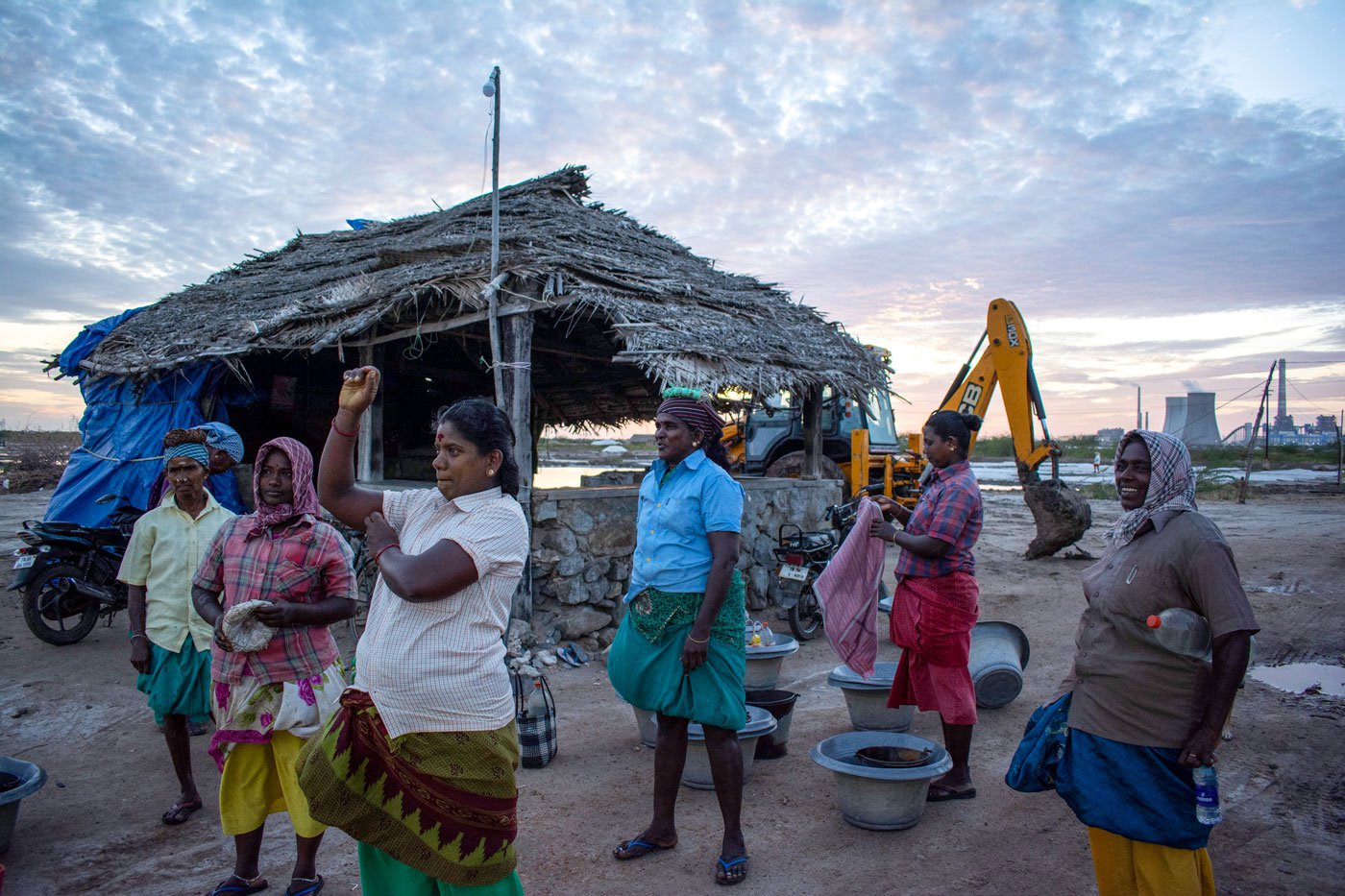
At dawn, Thoothukudint salt pan workers walk to their workplace, and get ready for the long hard hours ahead (Rani is on extreme right in a brown shirt)
This ‘crop’ in Thoothukudi is harvested from sub-soil brine which has a high concentration of salt and is saltier than sea water. This is pumped up through bore wells. In the 85-acre salt pans where Rani and her friends work, seven borewells flood the plots with four inches of water. (Each acre is roughly divided into nine plots and holds approximately four lakh litres. That’s as much as 40 large, 10,000-litre water tankers can hold.)
Few understand or explain the layout of the uppalam (salt pans) better than B. Anthony Samy, a salt worker for most of his 56 years. His job is to manage the water level in the different pans. Samy classifies the pans as aan pathis (male pans) that serve as ‘evaporators’ or shallow artificial salt pans, where the water gets removed through natural drying up. And secondly, penn pathis (female pans) that birth the salt, serving as crystallisers.
“Brine is pumped up and the evaporators are filled first,” he says.
Then he gets all technical.
The salinity is measured in degrees by a Baume hydrometer, an instrument that measures the specific gravity of liquids. The ‘Baume degree’ of distilled water is zero. For sea water, it ranges from 2 to 3 Baume degrees. Borewell water can range between 5 and 10 degrees. Salt is formed at 24 degrees. “As the water evaporates and salinity increases,” says Samy, “it is sent to the crystallisers.”
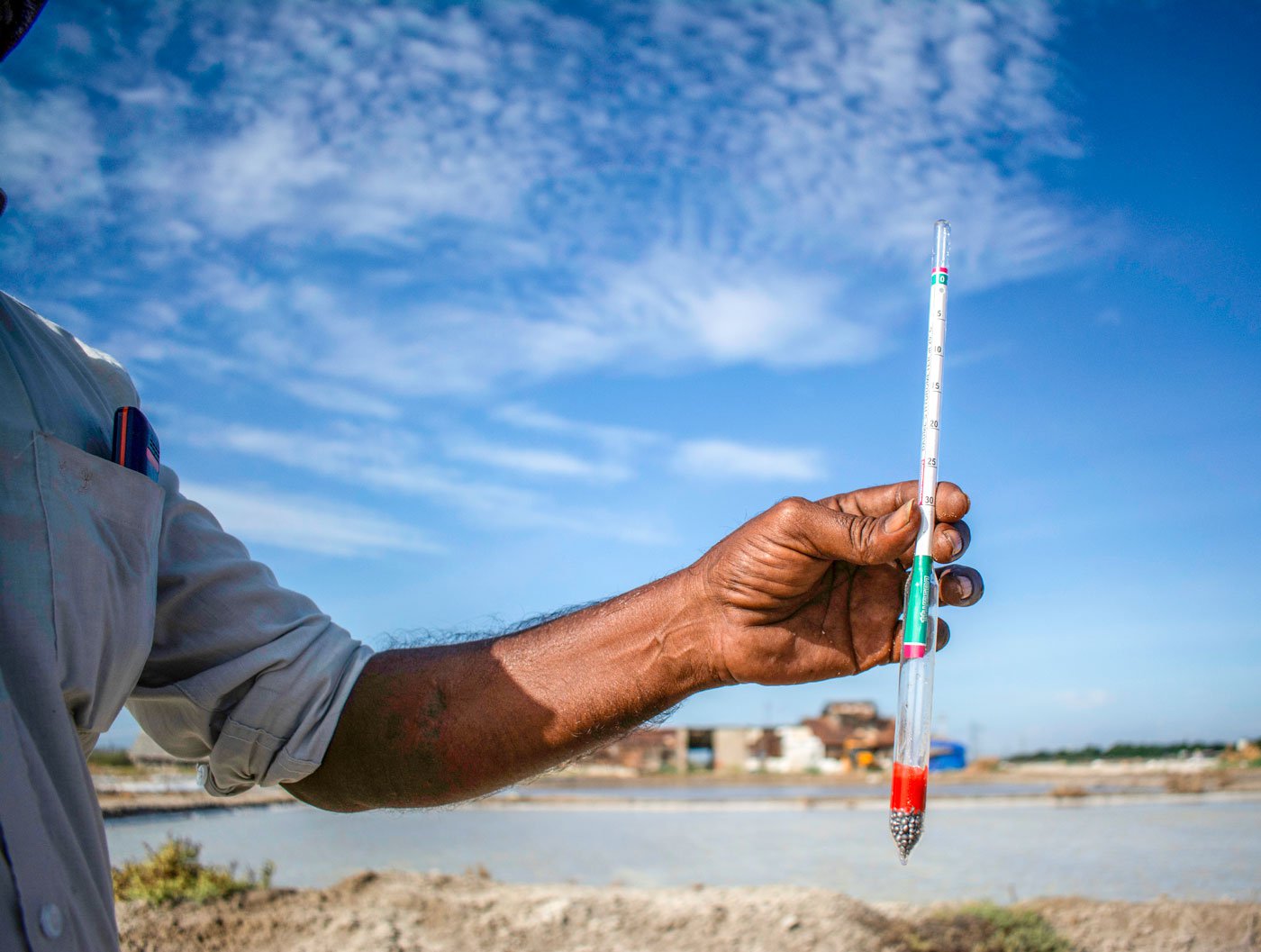
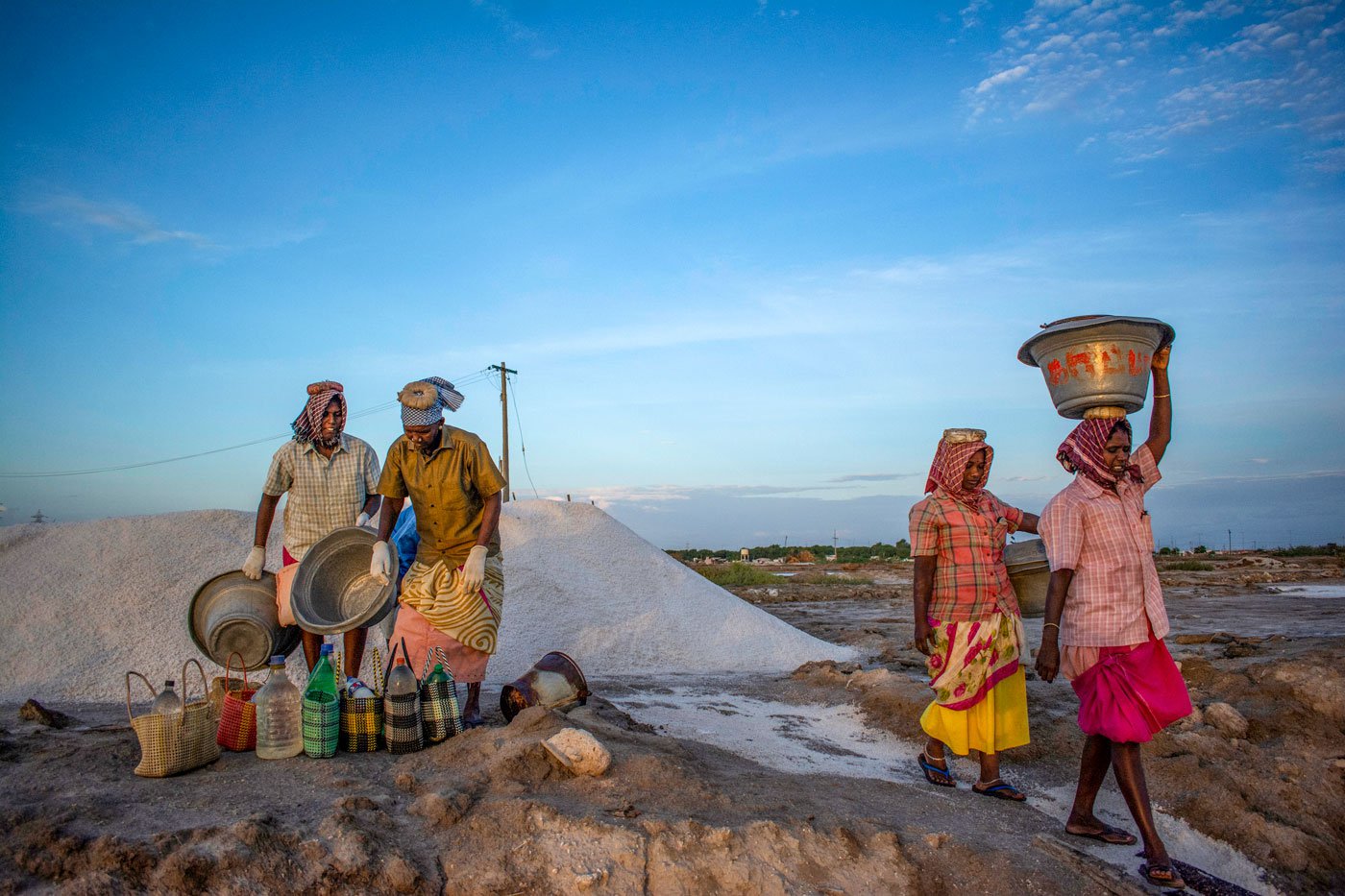
Left: The salinity is measured in degrees by a Baume hydrometer. Right: Carrying headloads from the varappu
For the next two weeks, the women here will drag behind them an extraordinarily large and heavy iron rake with which they stir the water every morning. They comb it lengthwise one day, and breadthwise the next, so that salt crystals do not settle down or crust over the bottom of the pan. After about 15 days, both men and women gather the salt using a giant wooden paddle. Next, they collect it on the varappu – the raised path between the pans.
Then comes the actual heavy lifting: women and men carry headloads from the varappu and empty it on higher ground. Each person is allotted a few strips of the varappu , from which they typically fetch and carry a whopping 5-7 tons of salt each day – on their heads. That means well over 150 trips a day carrying a headload of up to 35 kilograms each time across distances ranging from 150 to 250 feet. Their multiple trips to the place where they deposit their loads quickly transforms a molehill into a mountain, and under the high sun the salt glints like diamonds, a treasure in this hot, brown land.
*****
A lover's tiff is like salt to food. An excess of it is not good.
That’s a translation (and paraphrasing) of a couplet from the Thirukkural ( Sacred Couplets ) done by Chenthil Nathan. It is one among 1,330 couplets in the Thirukkural by Tamil poet-saint Thiruvalluvar, who is believed by different historians to have lived sometime between the 4th century BCE and the 5th century CE.
Simply put: salt as simile and metaphor had arrived in Tamil literature two millennia ago. And was harvested perhaps even earlier around what is now Tamil Nadu’s coastline.
Chenthil Nathan has also translated a poem from the 2,000-year-old Sangam era which references salt barter. And yet, the reference comes up in a verse centred on lovers.caused while hunting ferocious sharks,
has gone back to the blue sea.
My mom, in order to barter salt for rice,
has gone to the salt pans.
I think it would be nice
to have a friend, who won’t mind
the long distance and tiring walk,
to go and tell the man from cool long shores,
that if he wants to see me, this is the time to come!
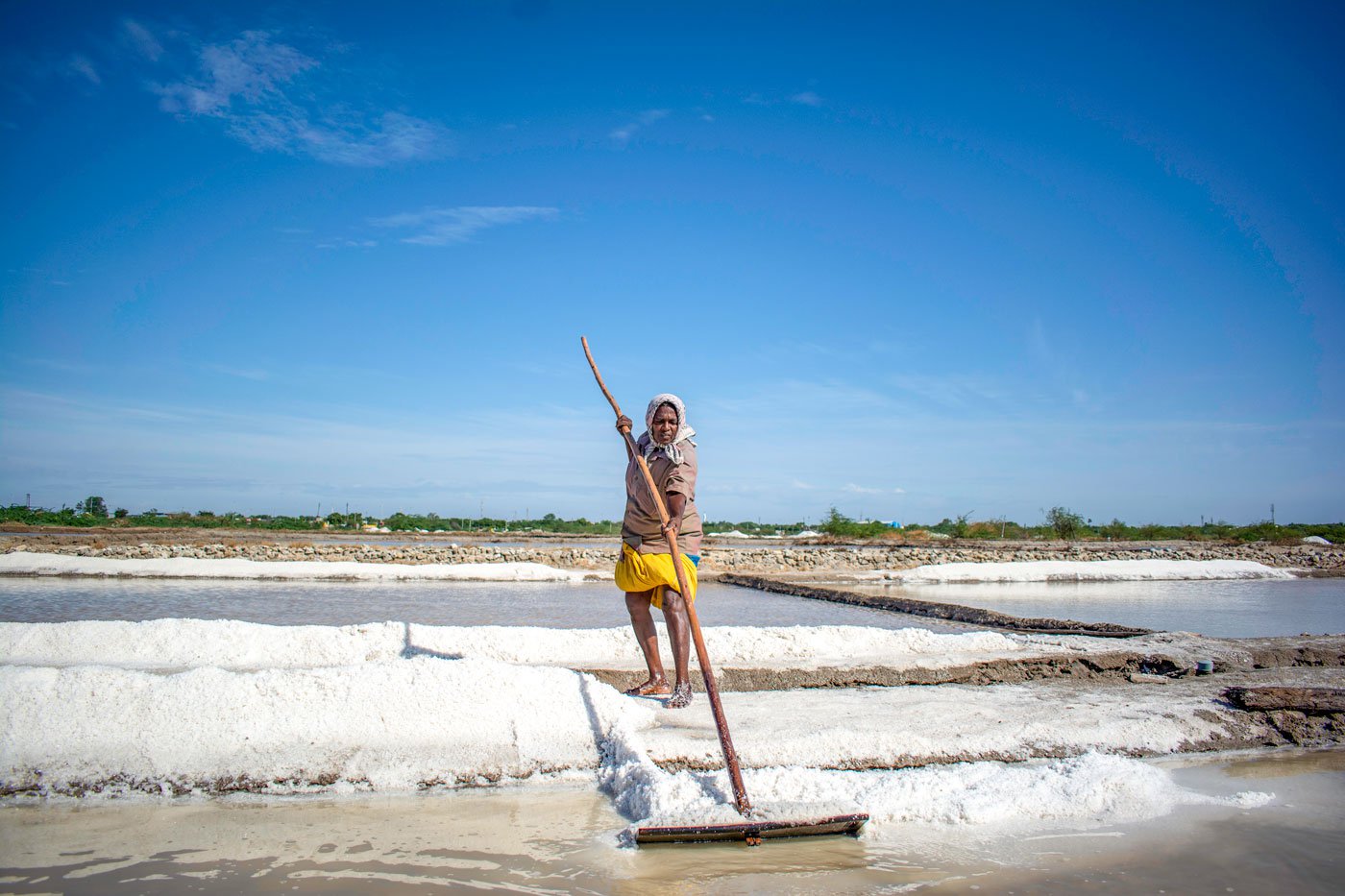
With a long wooden paddle, Rani gathers the most common, yet most important of kitchen staples: salt
Folklore and proverbs are also happy hunting grounds for salty sayings. Rani tells me one, the popular Tamil adage uppila pandam kuppayiley : food without salt is, literally, rubbish. Across her community salt is considered as Lakshmi, the goddess of wealth in the Hindu pantheon. “When someone moves house, we take salt, turmeric and water and leave it in their new home. It is auspicious,” says Rani.
In popular culture, salt symbolises loyalty. In fact, as the author A. Sivasubramanian observes: the Tamil word for ‘salary’ is sambalam – a combination of samba (which refers to paddy) and uppuallam (the site where salt is harvested). In his fascinating book Uppitavarai (a monograph on salt in Tamil culture), he also points to the widely used Tamil proverb – Uppitavarai ullalavum nenai – which essentially asks you to remember the person who salted your food. That is, your employer.
Salt was also to become, as Mark Kurlansky puts it, in his sweeping and spellbinding book Salt: A World History “one of the first international commodities of trade; its production was one of the first industries and, inevitably, the first state monopoly.”
This everyday ingredient helped change the course of India’s history, when Mahatma Gandhi, in March-April 1930, defied the repressive British Raj tax on salt and marched to collect it from the pans of Dandi, Gujarat. Later that April, his political lieutenant, C. Rajagopalachari, led the salt satyagraha in Tamil Nadu, from Tiruchirapalli to Vedaranyam. The Dandi march remains a vital chapter in the history of India’s struggle for Independence.*****
“Very poor wages for very hard labour.”
– Anthony Samy, salt pan worker
Rani’s first salary was 1.25 rupees a day. That was 52 years ago, when she was eight, wearing a long skirt, toiling in the pans. Anthony Samy too remembers his first pay: 1.75 rupees; years later that went up to 21 rupees. Today, after decades of labour struggles, the daily wage is Rs. 395 for women and Rs. 405 for men. And it remains, he points out, “very poor wages for very hard labour.”
“Neram aayittu,” it’s getting late, Rani’s son Kumar calls out in Thoothukudi’s distinct Tamil at 6 a.m. the next morning. We are already at the pans, and he is concerned about delays in getting down to work. From afar, the pans look like a painting – the sky is red and purple and gold; the water in the troughs shimmers; the breeze is kind, even the factories in the distance look benign. A beautiful landscape. In half an hour, I will learn how brutal it can be, when you work in it.
By the old shed – now dilapidated and dingy – in the middle of the salt pans, women and men gather and get ready. The women wear shirts over their sarees, and pin rolled-up cotton-fabric discs on their heads to cushion the heavy headloads. The workers then pick up their gear consisting of aluminium sattis (baskets) and buckets, also water bottles and food – old rice porridge in a steel thooku (small metal vessel with a handle). “We’re heading north today,” Kumar says, pointing to his left, and the group follows him, until they reach the two rows of pans they are to clear in the next few hours.
Quickly, they get to work. Women and men fold up their garments; sarees and petticoats and dhotis now brushing their knees. Crossing the two-foot water channel – over a rough and ready palm wood ‘bridge’ – they shovel salt with their buckets into the sattis . And once those baskets are full, they are lifted and placed on each other’s heads. Then, not unlike skilled tight-rope walkers, they stride up and down that narrow path – with water on both sides – 35 kilos of salt on their heads, climbing over the palm wood bridge, one, two, three…six steps.
At each journey’s end, in one graceful movement, they tip the sattis on the ground, the salt falling like white rain, and they go back for more… And again and again, each of them does that 150, even 200 times, until all the salt becomes one tall mountain, over 10 feet in height, more than 15 feet wide, an ambaaram (heap), as much a gift of the sea and sun as it is of the sweat of Rani and her people.
On the other side of the pans, 53-year-old Jhansi Rani and Anthony Samy are busy working. She drags the rake to stir, he uses the paddle to gather. The water moves with a gentle, gurgling sala-sala sound, the salt crunches. The day grows hotter, the shadows get darker, but nobody pauses, not to stretch their backs or even just to catch their breath. Borrowing a paddle from Anthony, I try dragging the salt towards the raised path. It’s brutish work. Five strokes later my shoulders are on fire, my back is sore, sweat stings my eyes.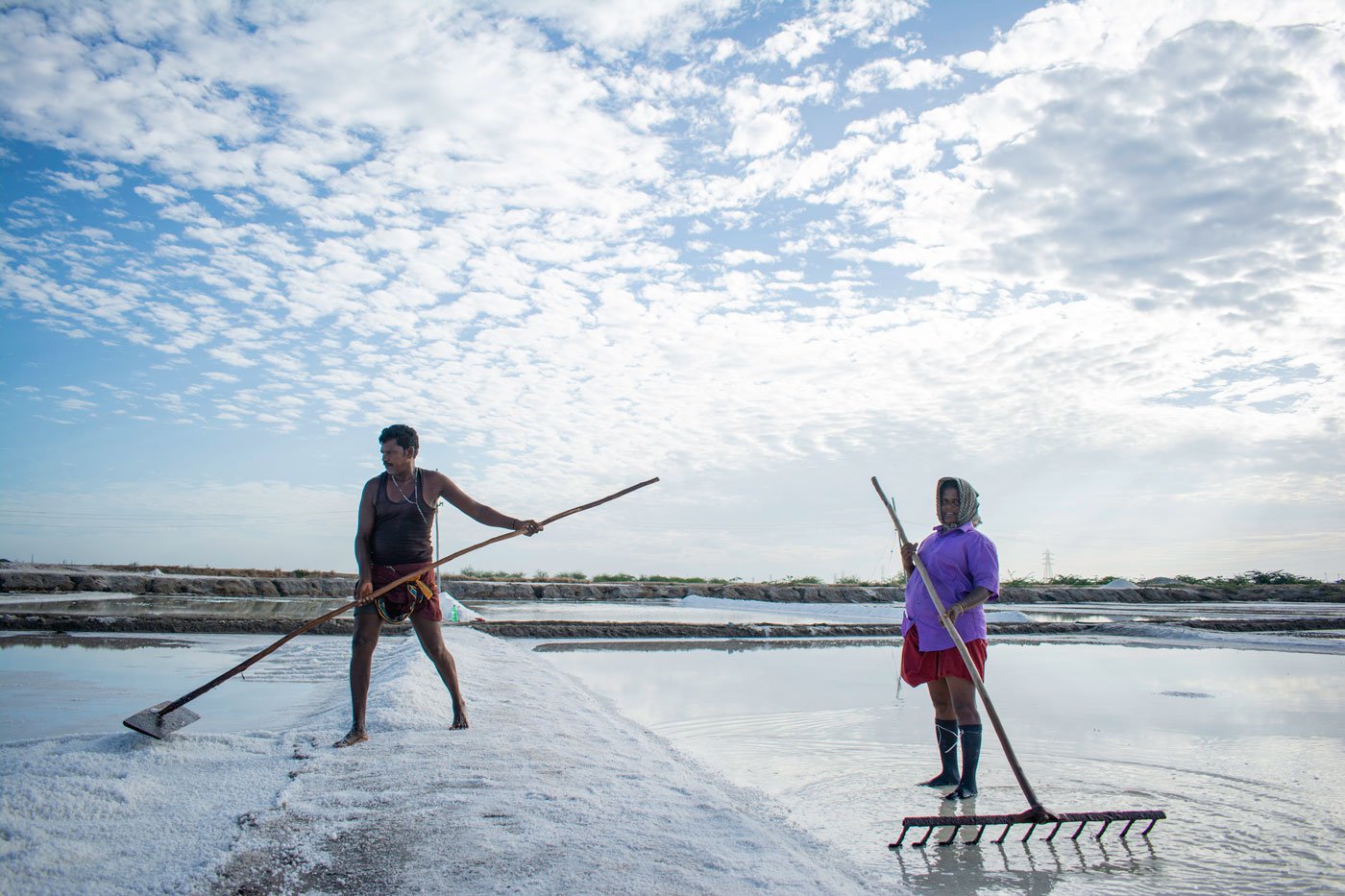
On the other side of the pans, Jhansi Rani and Anthony Samy are busy working. She drags the rake to stir, he uses the paddle to gather
Quietly, Anthony takes the paddle back and clears the plot of salt. I slink back to Rani’s pans. She is finishing up at the last one, her muscles clenching, pulling, straining, over and over, until all the white follows her to one side, and the pan stands naked and brown, ready for a fresh batch of water, and another harvest of salt.
Once she levels the uneven heap with the edge of her paddle, Rani invites me to sit with her. And so we do, next to a hillock of blinding-white salt, and watch a very long goods train in the distance.
“Once there were goods trains that came to collect salt from these pans,” says Rani, tracing the old route with a finger in the air. “They’d leave a few carriages on the tracks, and later, the engine would come and take them away.” She speaks of bullock carts and horse carriages and the shed where the salt factory once functioned. Now there is only the sun and salt and work, she says, and takes out a draw-string pouch from her waist – it holds a tiny two-rupee tin of Amrutanjan and a Vicks inhaler. “This [and her diabetes tablets] is what keeps me going.” She smiles.
*****
“If it rains for a day, we’re jobless for a week.”
– Salt pan workers in Thoothukudi
The work hours too have changed with time. From the traditional 8 a.m. to 5 p.m. – with an hour-long lunch break – some groups now work between 2 a.m. and 8 a.m. and others between 5 a.m. and 11 a.m. These are the shifts when the hardest work gets done. There are still some chores to be attended to after these hours as well. And a few workers linger on to deal with those.
“It’s just too hot to stand there after 10 a.m.,” Anthony Samy says. He has witnessed and experienced, first-hand, the erratic changes in temperature and climate. Data from an interactive portal on global warming of the New York Times bear out his personal observations on how the climate has altered.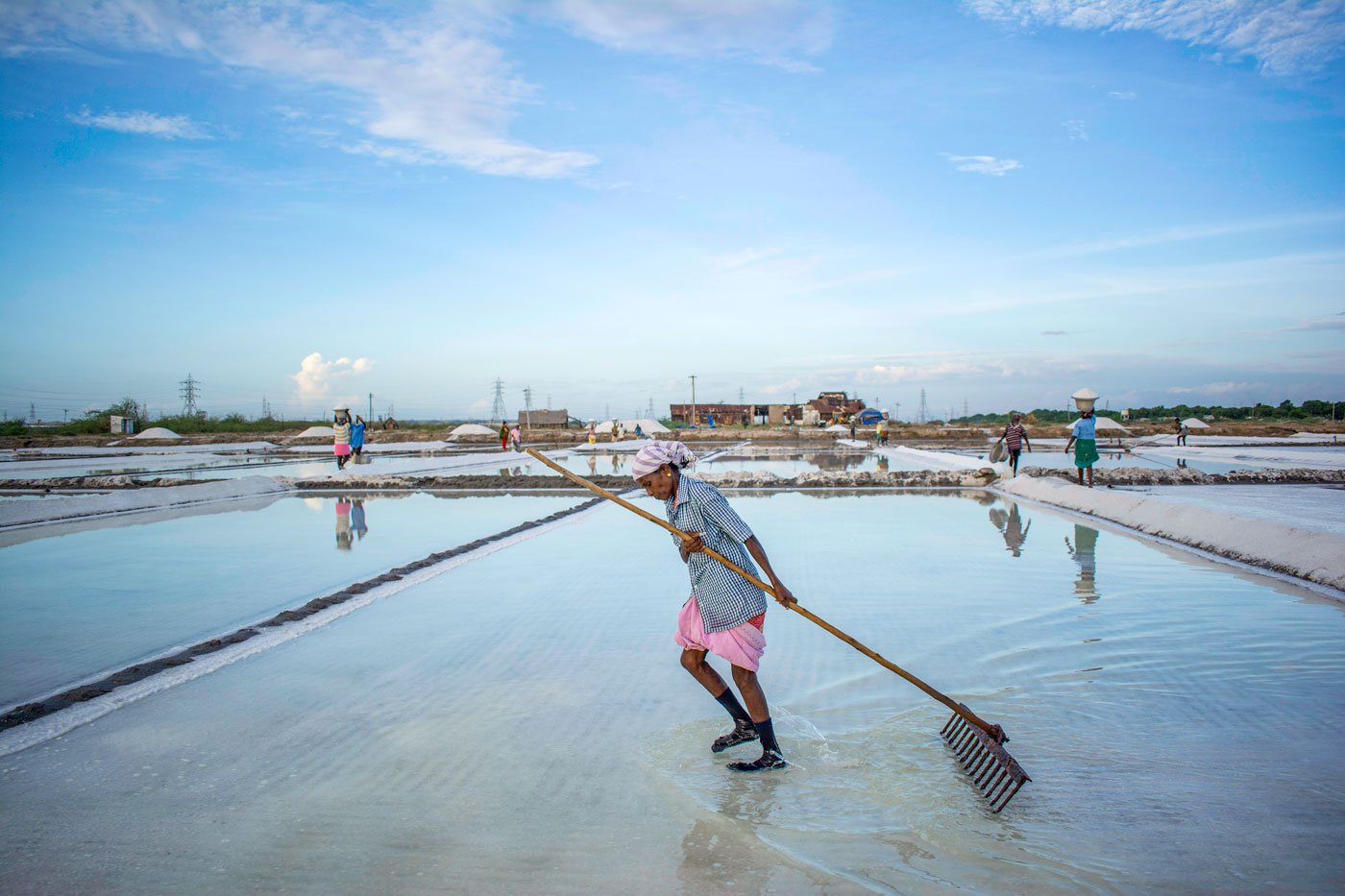
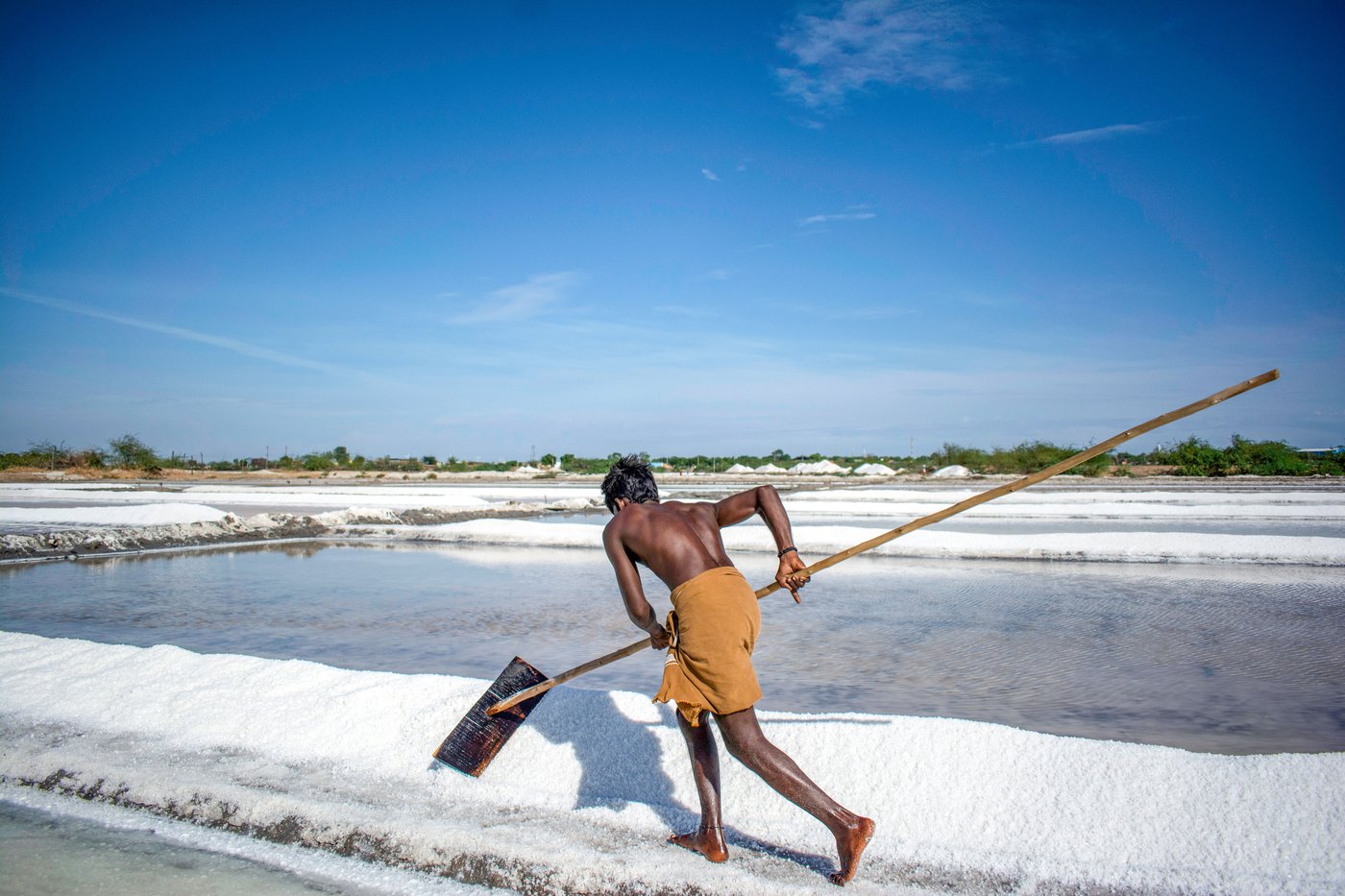
For two weeks, the women drag behind them a very heavy iron rake with which they stir the water every morning. After about 15 days, both men and women gather the salt using a huge wooden paddle
When Anthony was born in 1965, Thoothukudi (then called Tuticorin) could expect 136 days in a year when temperatures would cross 32 degrees. Today, say the data, that would be 258 days a year . An increase of 90 per cent in hot days in his lifetime.
Accompanying that is a rise in unseasonal rainfall.
“If it rains for a day, we’re jobless for a week,” say the workers in one voice. They speak of the rain washing away the salt, the sediment, the structure of the pans, the days of sitting idle with no money.
Many local transformations too, feed into the problem of erratic weather and climate. Trees that offered slivers of shade have been chopped; now it’s just bare, blue skies, lovely to photograph, wretched to work under. The salt pans have also become inhospitable because “the owners previously used to keep some water for us, now we have to carry it from home, in bottles,” Jhansi tells me. What about toilets, I ask. The women laugh, derisively. “We use the fields behind the pans,” they say. Because while there is a toilet, there’s no water to use it.
The women also face other challenges at home, mostly to do with their children. When they were young, says Rani, she would take her kids with her and tie a thooli , a cloth cradle, in the shed and go to work. “But now, my grandchildren have to be left behind at home. They say the pans are no place for kids.” Fair enough, but it does mean the children have to be dropped off at neighbours’ and relatives’ homes – or left unattended. “You can take small kids to the balwadi only after they’re 3 years old. In any case, the working hours there – starting after 9 a.m. – don’t coincide with our timings.”*****
“Here, see my hands, feel them, aren’t they like a man’s?”
– Women salt pan workers
The women are most animated when they talk of their bodies, the unbearable price they pay for their work. Rani begins with her eyes. Constantly staring at the sparkling white landscape makes them tear up and sting, and she squints in bright light. “They used to give us dark glasses,” she says, “but now, they give us a little money.” Usually 300 rupees annually, for glasses and footwear.
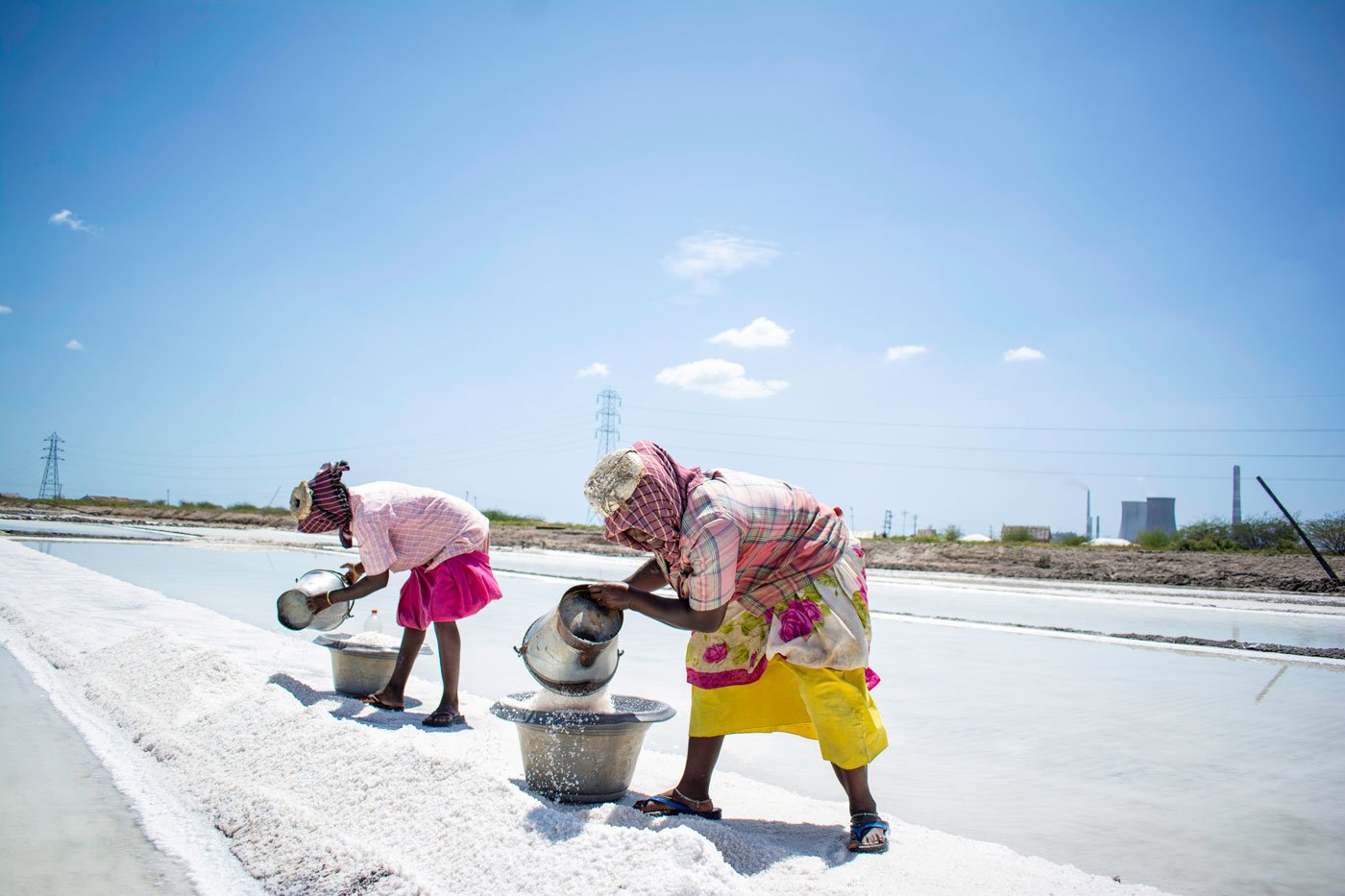
Not one person wears goggles to protect their eyes from the blinding reflections of the white landscape
A few women wear black socks with a refurbished base: that is, a piece of rubber tubing stitched to the bottom. But not one person in the salt pan wears goggles. “A good pair costs 1,000 rupees, cheap ones serve no purpose, and are more of a hindrance,” they all tell me, and point out that they suffer damaged vision by the time they’re 40.
More women join Rani. They complain loudly of hardly ever getting a break, never enough drinking water, the beating sun, the brutal heat, the brine that ruins their skin. “Here, see my hands, feel them, aren’t they like a man’s?” And palms and feet and fingers are presented to me, the toenails blackened, shrivelled; the hands callused, raw; and the legs with many blemishes, small wounds, which refuse to heal, and throb each time they step into the salty water.
The stuff that makes our food tasty, eats their flesh.
The list moves inwards. Hysterectomies, kidney stones, hernias. Rani’s son Kumar is 29 years old, stocky and strong. But the heavy lifting he did at work gave him a hernia. He had a surgery, rested for three months. What does he do now? “I continue to lift heavy loads,” he says. He doesn’t have a choice. There isn’t much else to do around town.
Some youngsters around here find work in prawn units or flower factories. But the salt pan workers are mostly over 30 years old and have laboured in their line for decades. Kumar’s grouse though is with the pay. “Packers are like contract workers, and we don’t even get a bonus. A woman is paid 1.70 rupees to hand-pack a kilo of salt into each of 25 packets. [Less than 7 paise a packet]. Another woman is given 1.70 rupees to seal all 25 of them. Yet another worker, usually a male, is paid 2 rupees to fit the 25 packets into a single sack, stitch it by hand, and arrange it in a neat pile. The taller the stack grows, the more the strain on the worker’s body. But the pay remains the same: 2 rupees.”
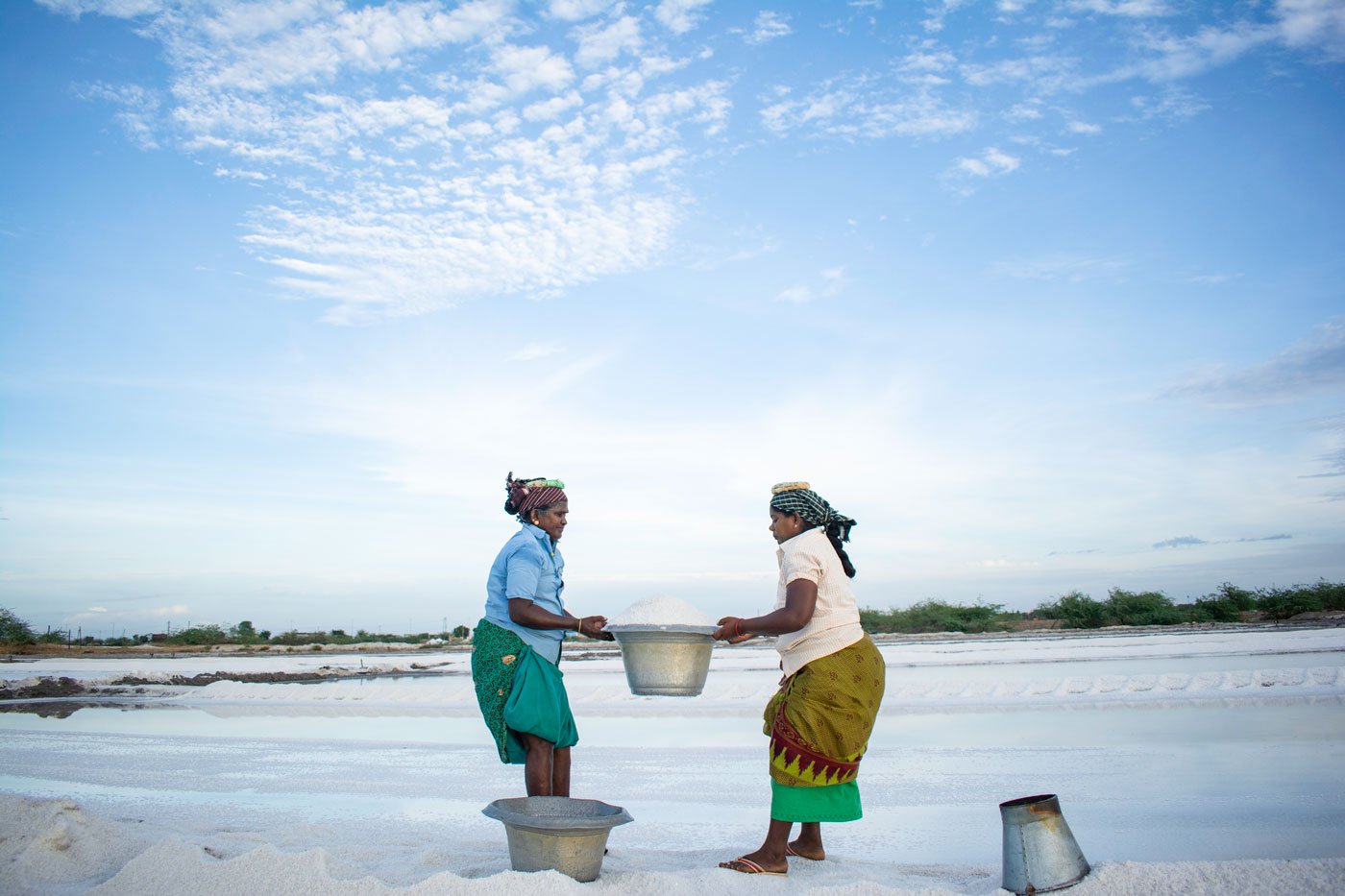
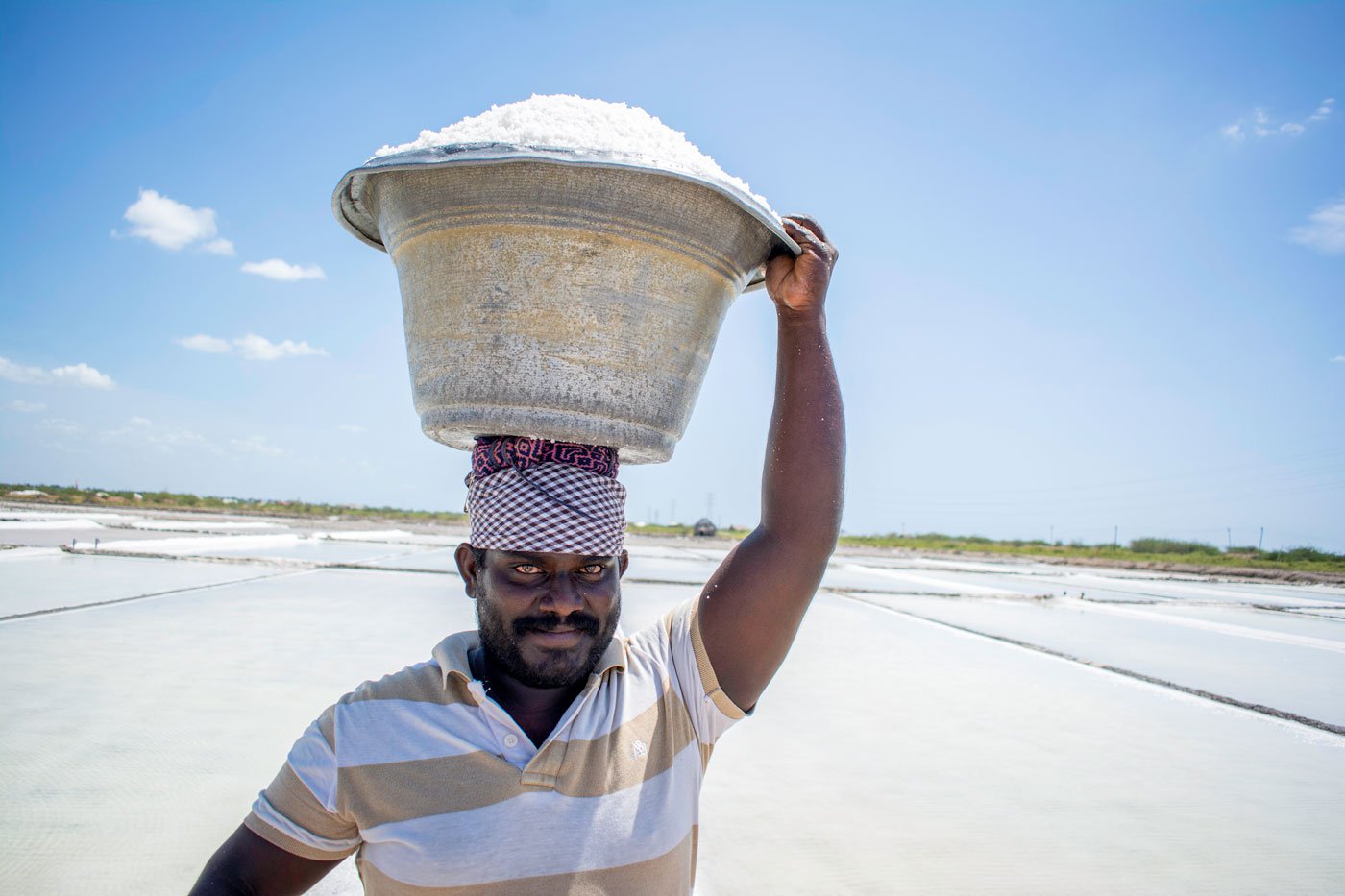
The women speak of hardly ever getting a break, never enough drinking water, the brutal heat, the brine that ruins their skin. As well as hysterectomies, kidney stones, hernias. Rani’s son Kumar (right) is stocky and strong. But the heavy lifting he did at work gave him a hernia that needed surgery
Dr. Amalorpavanathan Joseph, vascular surgeon and member, Tamil Nadu State Planning Commission, says that “Medically, whatever footwear they’re contriving and using can never be leak-proof or toxin-proof. Working one or two days is okay. But if this is going to be your lifetime occupation, you need scientifically designed boots that are replaced at frequent intervals. If this is not ensured, your foot health cannot be guaranteed at all.”
Apart from the blinding white light that is reflected from the salt, he believes “there will be many irritations in the eyes from working in such an environment without goggles.” He advises regular medical camps, and frequent checking of the blood pressure of all the workers. “If there’s anybody with a reading higher than 130/90, I wouldn’t allow them to work in a salt pan.” It’s possible that the workers absorb some amount of salt as they toil in that environment, he says. And daily carrying of those loads of salt involves five to six physically demanding manoeuvres. “If you calculate the energy spent, it will be phenomenal.”
These workers may have been in this line for four or five decades. But with no social security, no paid leave, no childcare or pregnancy benefits, the salt pan workers point out, they are no better than ‘coolies’ (low-wage workers).
*****
“Salt has more than 15,000 uses.”
– M. Krishnamurthy, district coordinator, Thoothukudi, Unorganised Workers Federation
“India is the third largest manufacturer, after the USA and China,” says Krishnamurthy. “It’s impossible to live without salt, and yet, the lives of these workers are as salty as their crop!”
There are 50,000 salt workers in Thoothukudi district, estimates Krishnamurthy. That is, 1 in every 15 in a district of 7.48 lakh workers is in this sector. They only have work, though, during the hot season of roughly 6-7 months between February and September. Central government figures place their number at a far lower 21,528 salt workers – and that for all of Tamil Nadu. But that’s where Krishnamurthy’s Unorganised Workers Federation comes in. They record a huge number of labourers who they find excluded from the official count.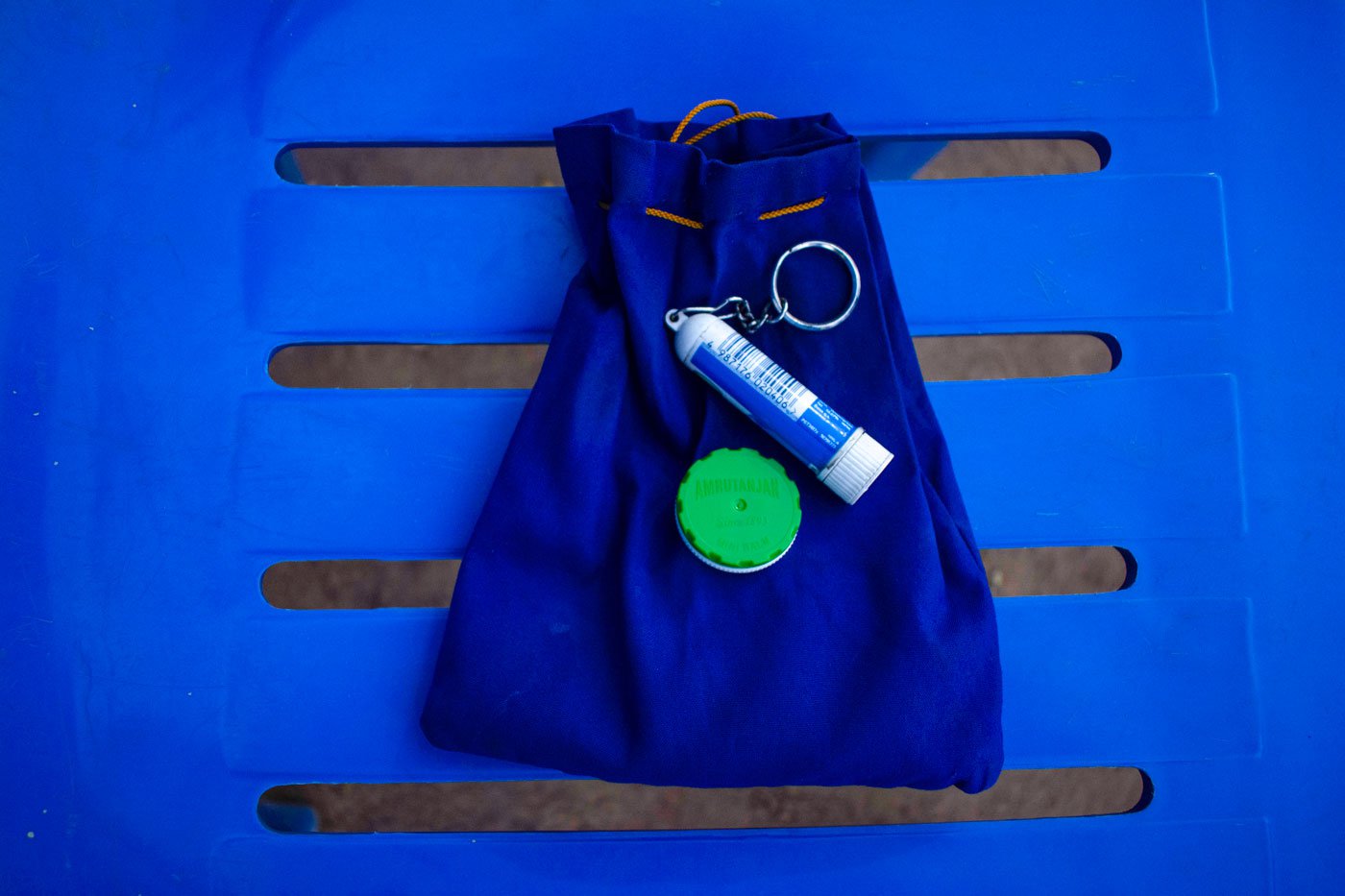
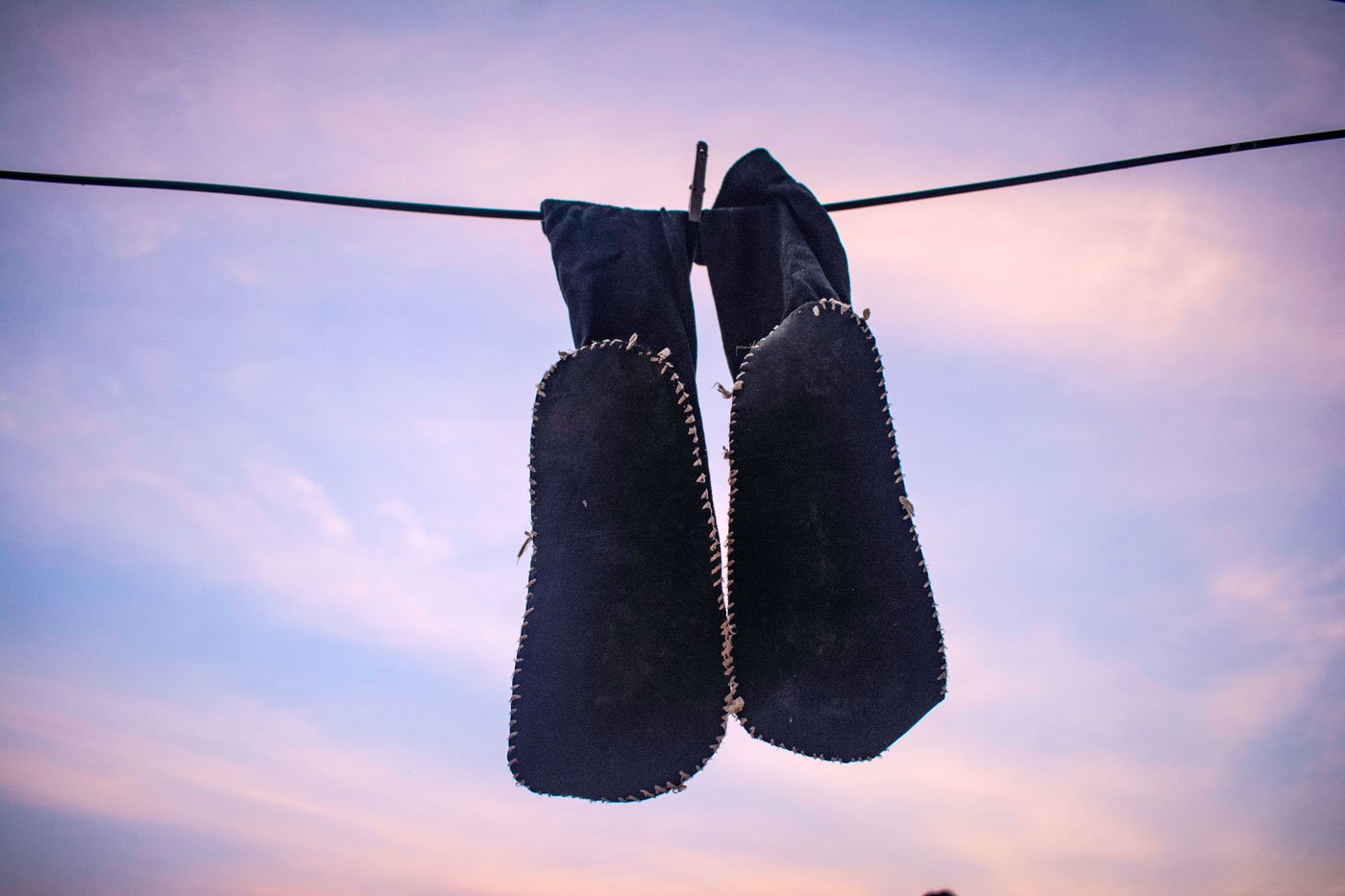
Left: Rani’s drawstring pouch with her Amrutanjan and inhaler. Right: A few women wear black socks with a with a rudimentary refurbished base
Each salt worker here – whether scraping the crystallisers or fetching and carrying the salt – shifts about 5 to 7 tons every single day. The value of this salt – at the current price of 1,600 rupees a ton – is upwards of 8,000 rupees. But a single unseasonal shower, as they emphasise, can disrupt work for up to a week or 10 days.
However, what hurt them most, says Krishnamurthy, are the post-1991 policies of liberalisation, intensifying in recent years – when “big, private players were allowed into the market.” For generations, he says, “it’s been mostly Dalits and women who have harvested salt from this harsh land. Between 70 and 80 per cent of the workers are from these marginalised backgrounds. Why aren’t the salt pans leased to them directly? How can they compete with big corporates for this land in an open auction?”
When corporations enter the scene and the size of the holdings grow very large – from tens of acres to thousands – Krishnamurthy is certain the operations will get mechanised. “What then of the 50,000 salt workers?”
There is no work every year from October 15 – when the northeast monsoon typically begins – until January 15. These three months are harsh, and the households run on borrowed money, buried dreams. M. Velusamy, 57, a worker at the pans, talks about the changing contours of salt making. “In my parents’ time, small producers could harvest and sell salt.”
Two policy changes ended all that. The central government declared in 2011 that salt for human consumption had to be iodised. A little later it changed the lease agreements for all the salt pans. It had the power to do so, as salt falls in the Union list in the Constitution.
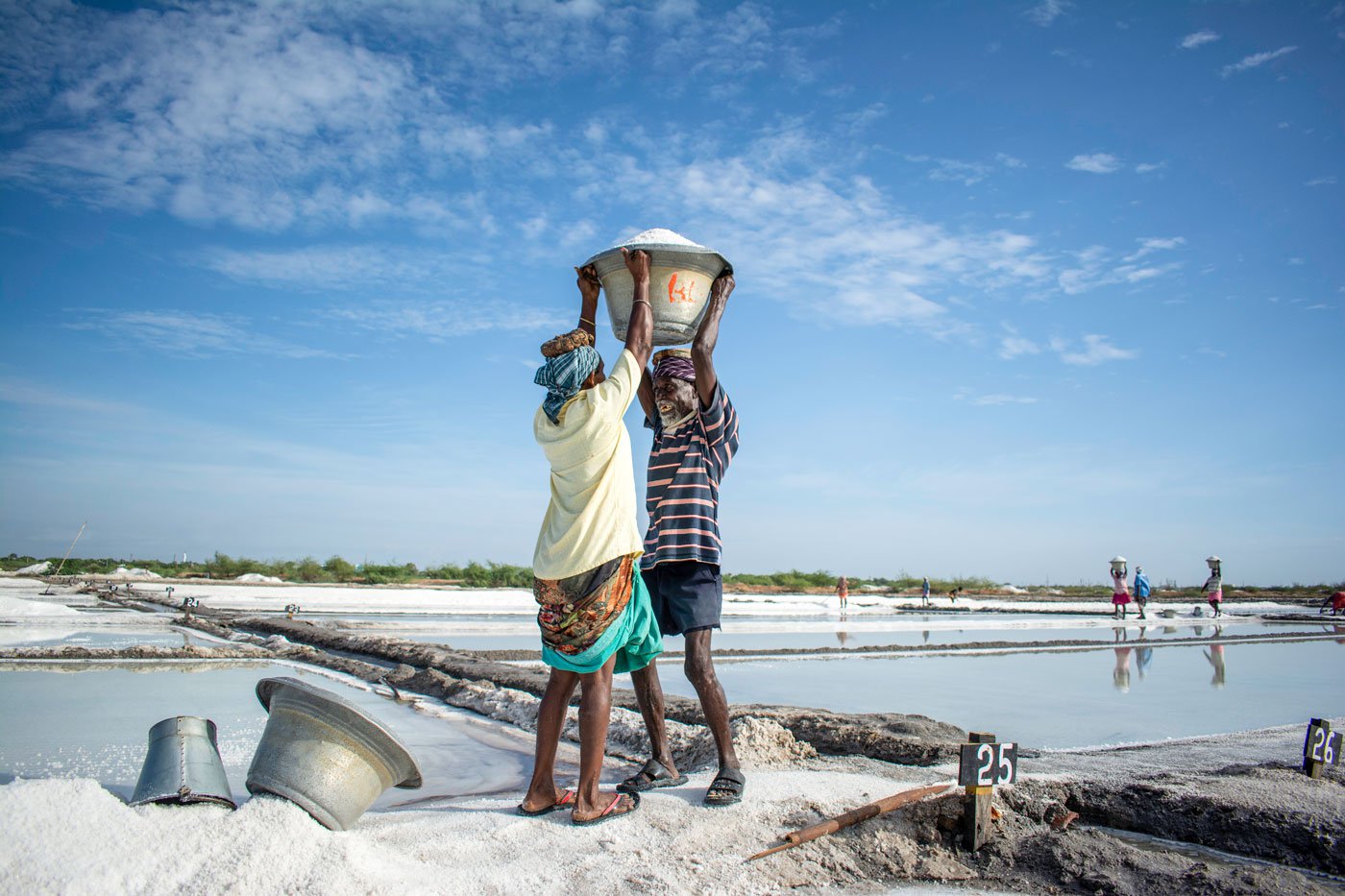
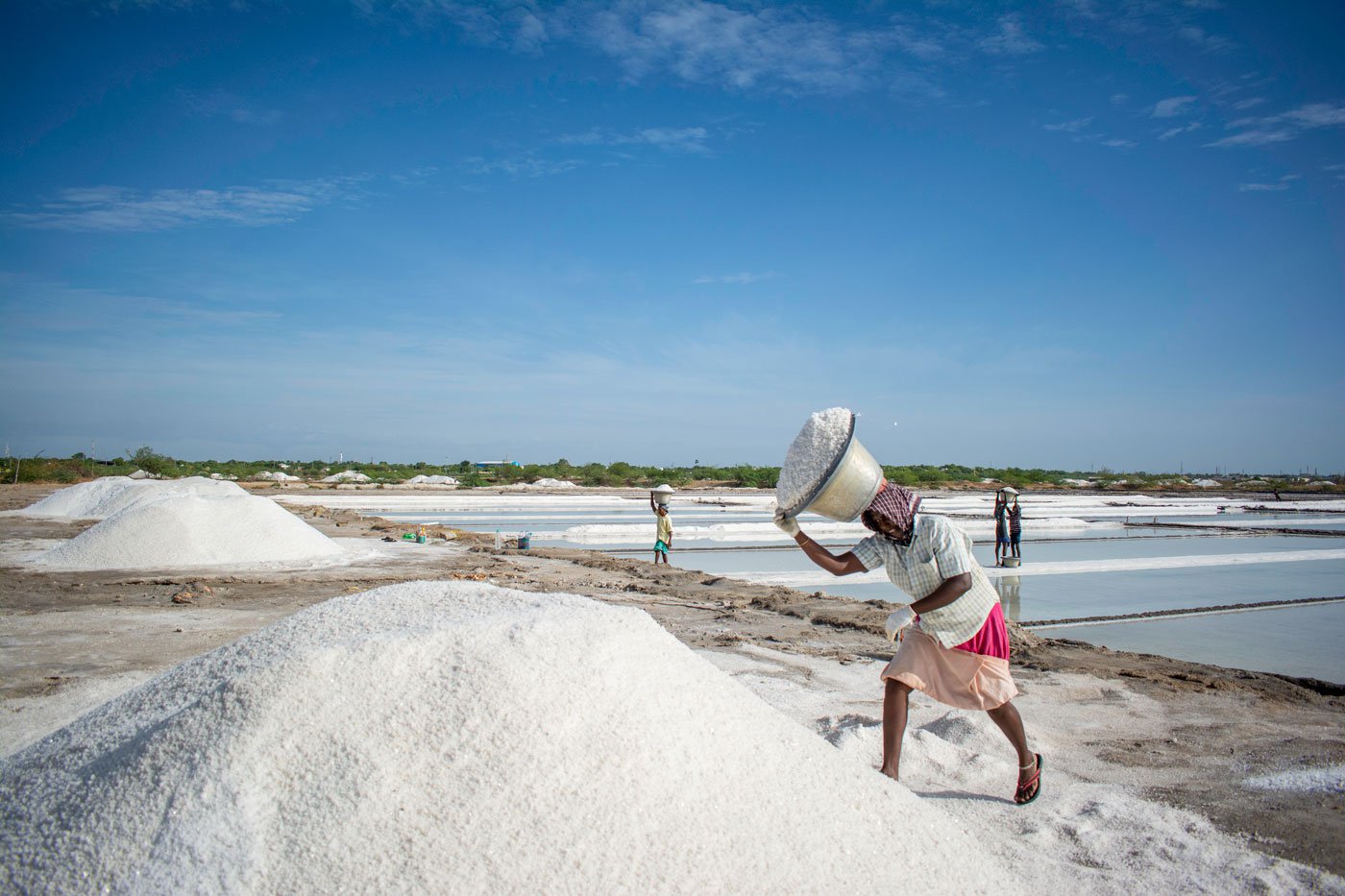
The sale pan workers may have been in this line for four or five decades, but still have no social security, no paid leave, no childcare or pregnancy benefits
The 2011 Government of India regulation stated that “no person shall sell or offer or expose for sale or have in his premises for the purpose of sale, the common salt, for direct human consumption unless the same is iodized .” This meant common salt could only be a factory product. (A few categories like rock salt, black salt and Himalayan pink were exempted.).It also meant these traditional salt harvesters had lost their agency. This was challenged legally and the supreme court actually criticised the provision strongly – but the ban remains effectively in force . Common salt that is used for food cannot be sold unless iodised.
The second of those changes happened in October 2013. A central notification said, among other things: “Central government land will be leased out for salt manufacture by invitation of tender.” Further, no existing lease would be renewed. Fresh tenders would be called for, and where the lease expires, the present lessee “can participate along with fresh aspirants.” This is obviously favourable only to large producers, says Krishnamurthy.
Four decades ago, Jhansi recalls, her parents had sub-leased land, raising water from a dug well with a hand pulley (and a palm leaf basket as a bucket) and harvesting salt on 10 tiny plots. Every day, her mother would carry 40 kilos of salt on her head (again, in a palm leaf basket), and walk all the way to town to sell it. “Ice companies used to buy her entire load for 25 or 30 rupees,” she says. And when her mother couldn’t go, she’d send Jhansi with a smaller basket. She even recalls selling a measure of salt for 10 paise. “The land where our pans stood now has buildings – residential quarters – over it,” Jhansi says. “I don’t know how the land went away from our hands,” she adds glumly, her voice rich in lament, the air thick with salt.
Life was always hard, the salt workers say. For decades, their meals were mostly tapioca and millets (rarely rice) with a side of fish, boiled into a kozhambu (gravy). And idli – the now ubiquitous food – was an annual treat, made for Deepavali. Jhansi recalls being too excited to sleep the night before, all because they’d be given idlis on the morning of the festival day.
Deepavali and Pongal, the two big festivals, were the only occasions they got new outfits. Until then, they wore old, worn-out clothes, especially the boys, whose “trousers had 16 holes, each of them mended with a needle and a thread,” says Jhansi, her hands sewing the air deftly. On their feet, they wore flat palm leaf footwear, hand-made by their parents, a jute cord keeping it all in place. It offered enough protection, as the salinity in the pans wasn’t as high then as it is now – when salt is an industrial commodity, and its household use is just a small part of total consumption.
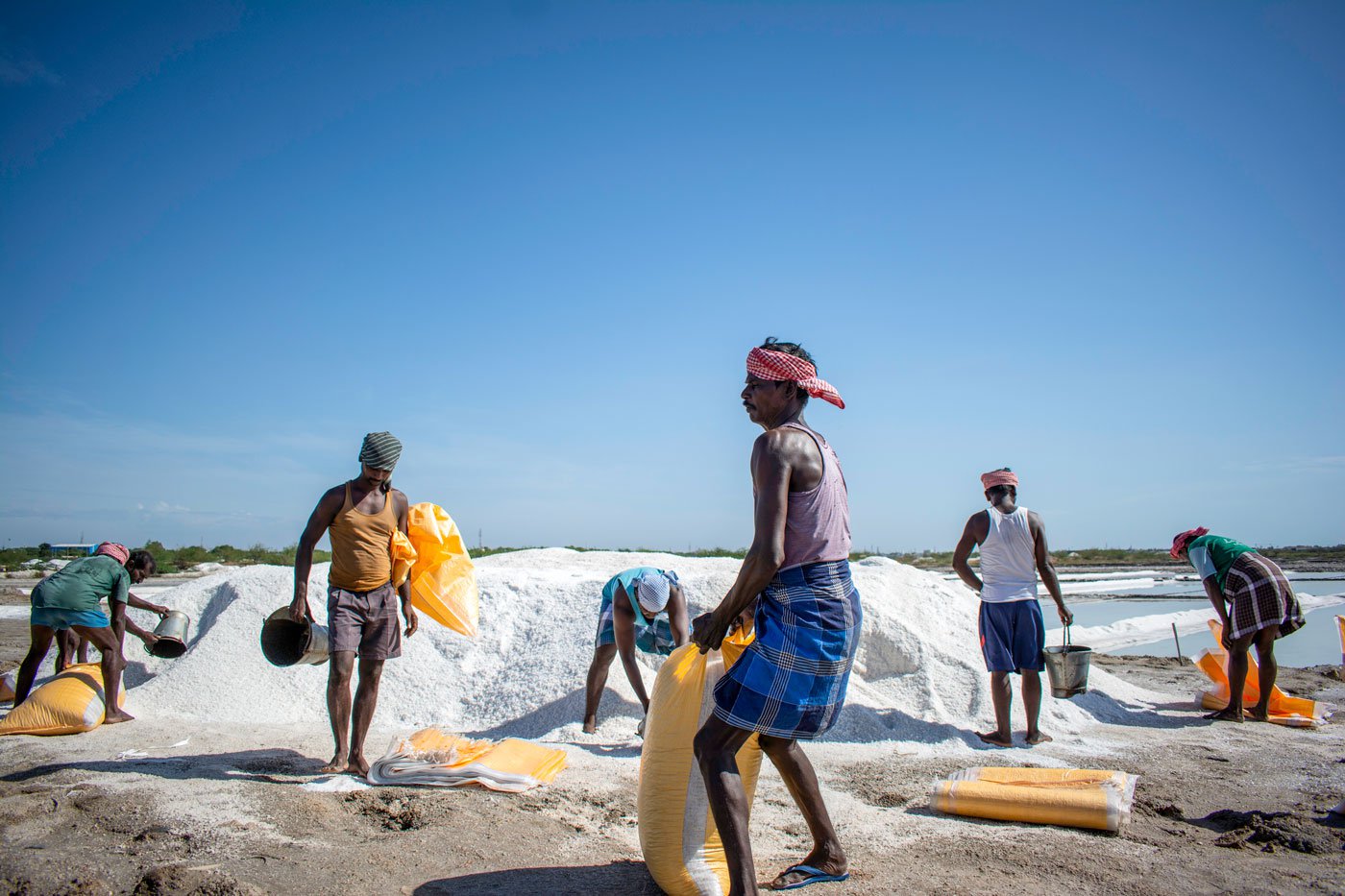
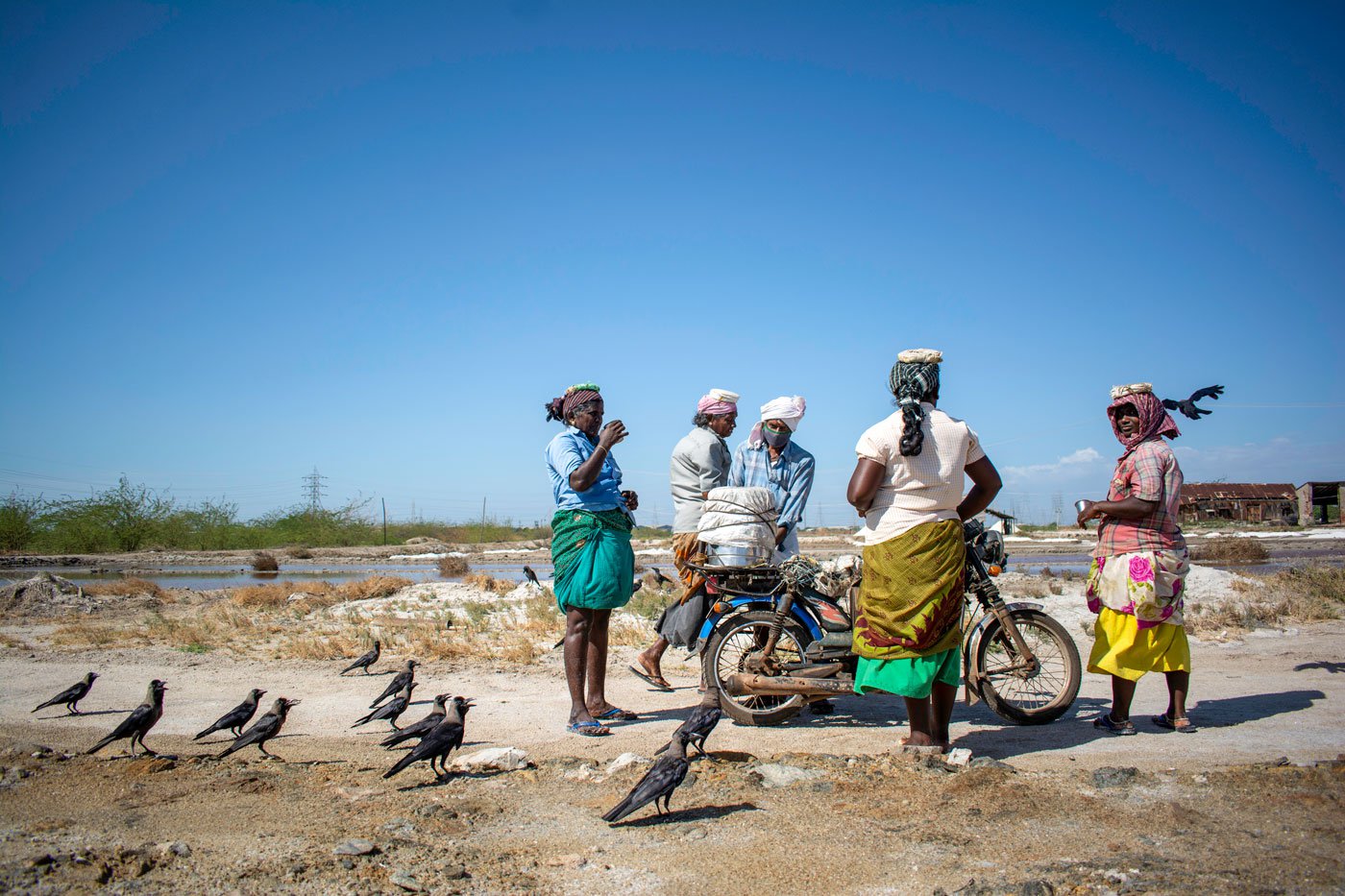
Life has always been hard, the salt workers say. They only get a brief break between work, to sip some tea, in their shadeless workplace
*****
“I can write my name, read the bus routes, and also sing MGR songs.”
– S. Rani, salt pan worker and leader
In the evening, after work, Rani invites us home – a small sturdy room, with a sofa and bicycle and clothes that hang on a rope. Over cups of warm tea, she talks of her wedding at the registrar’s office, when she was 29. Which was unusually late for those times for a village woman. Her family’s poverty was probably the biggest cause of that delay. Rani has three daughters – Thangammal, Sangeetha and Kamala – and a son, Kumar, who stays with her.
Even when she did get married “we had no money for ceremonies,” she says. Then she shows us photo albums – her daughter’s puberty function, another’s wedding, the family wearing fine clothes, her son Kumar dancing, singing…all of it paid for by hauling salt.
While we chuckle and comment, Rani finishes a hand-made green wire basket, tucking in the edges, tightening the handle. It was Kumar who made it from scratch, learning the gooseberry pattern from a YouTube video. Some days, he doesn’t have the time for all this. He goes for a second shift at some other salt pan, to earn a little extra. The women always have a second shift at home, he points out, “they hardly get any rest.”
Rani never got any, not even when she was very young. She was only three when she was sent to the circus with her mother and sister. “It was called Tuticorin Soloman Circus, and my mother was a champion on the ‘hi-wheel’ [one-wheel] cycle.” Rani was adept at the bar, her sister at juggling. “My sister could walk on a tightrope. I used to bend backwards and pick up cups with my mouth.” With the circus troupe, she travelled to Madurai, Manapparai, Nagercoil, Pollachi.
When she was eight, Rani was sent to work in the pans whenever the circus came back home to Tuticorin. Since then, the salt pans became Rani’s world. That was also the last time she went to school. “I studied till Class 3. I can write my name, read the bus routes, and also sing MGR songs.” Earlier in the day, she began singing along with the radio an old MGR song which speaks of doing good.
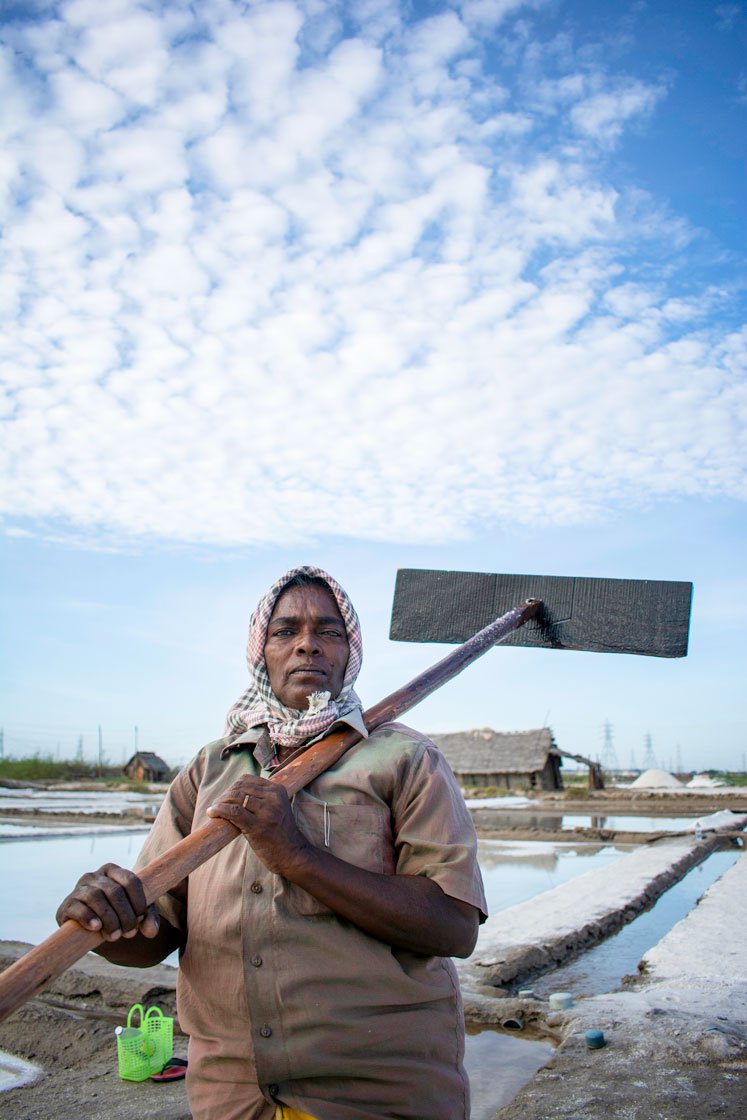
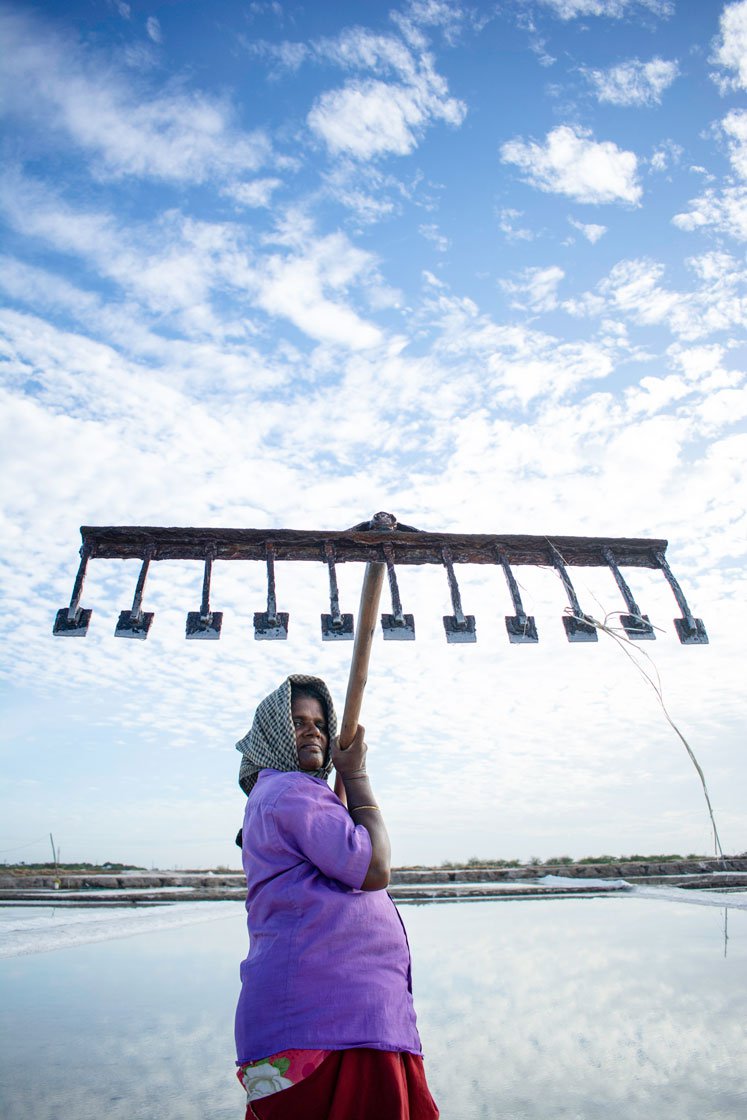
Rani and Jhansi with their heavy tools: just another day of backbreaking labour
She’s also such a good dancer, her co-workers tease. Rani blushes when they mention her recent Karagattam performance for a function presided over by the member of Parliament from Thoothukudi, Kanimozhi Karunanidhi. Rani is also learning to speak on stage, and as a leader – of her kuzhu , self-help group of women, as well as of the salt workers – she travels to make representations to the government. She smiles as her co-workers say: “She is The Rani of these salt pans.”
It was for one such trip – a meeting organised by Krishnamurthy in 2017 – that she had gone to Chennai. “So many of us went there for three days, it was such a jolly trip! We stayed in a hotel room, visited the MGR samadhi , the Anna samadhi . We had noodles and chicken and idli and pongal. It got very dark by the time we went to Marina beach, but it was great!”
At home, her meal is simple. She cooks rice and a kozhambu (gravy) – typically, with fish or onions or beans. For the side, there is karuvaadu (dried salted fish), plus some vegetable, usually cabbage or beetroot. “When we’re short of money, we simply have black coffee.” But she doesn’t crib. A Christian, she attends church and sings hymns. After her husband Sesu passed away in an accident, her children – she mentions her son specifically – have been good to her. “Onnum kurai solla mudiyadhu,” I cannot complain about anything. “God has given me good children.”
When she was pregnant with them, she continued to work till the day of delivery – when she would walk to the hospital directly from the salt pans. “My stomach used to rest here,” she says, patting her thigh near her knee. Then 13 days after delivery, she was back at the pans. And to keep the child from crying in hunger, she would make a thin gruel with tapioca flour. Two spoons of that flour would be wrapped in a cloth, dipped in water, boiled, and filled into a gripe water bottle with a rubber teat – and someone would feed this to the child until she could get back to breastfeed.
Periods were equally difficult, with much chafing and burning. “In the evening, after a warm bath, I applied coconut oil on my thighs. So that I could go back to work the next day…”
With her years of experience, Rani can – just by looking and feeling the salt – tell if it is of food grade. Good rock salt has evenly sized crystals and is not sticky. “If it is pisu-pisu [clammy] – it won’t taste good.” The salt that’s manufactured scientifically, with Baume thermometers and extensive irrigation pathways, is driven by a single aim – to harvest a great quantity of the item. That mandate may be met, she tells me, but much of that salt is better suited for industrial purposes.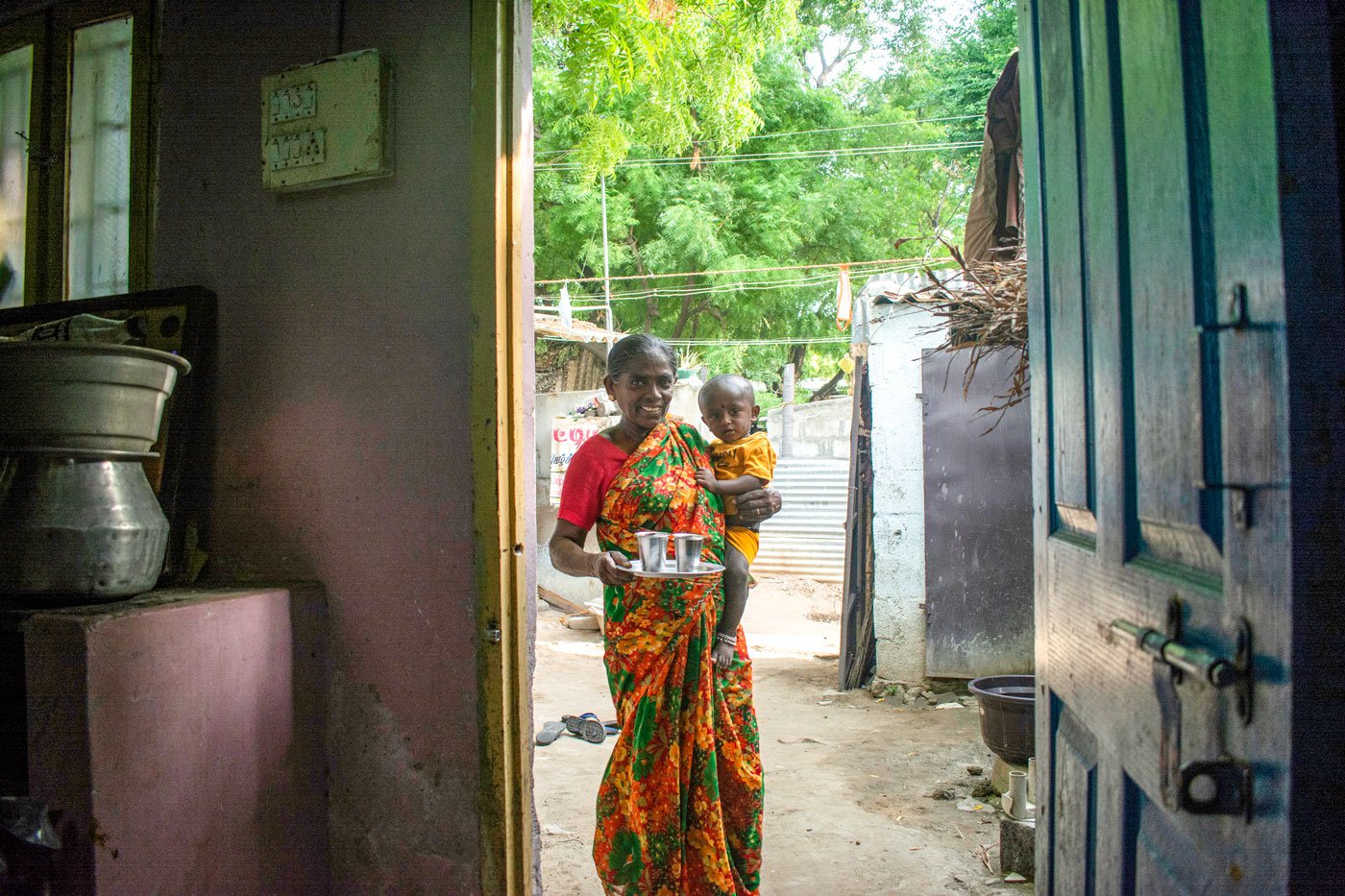
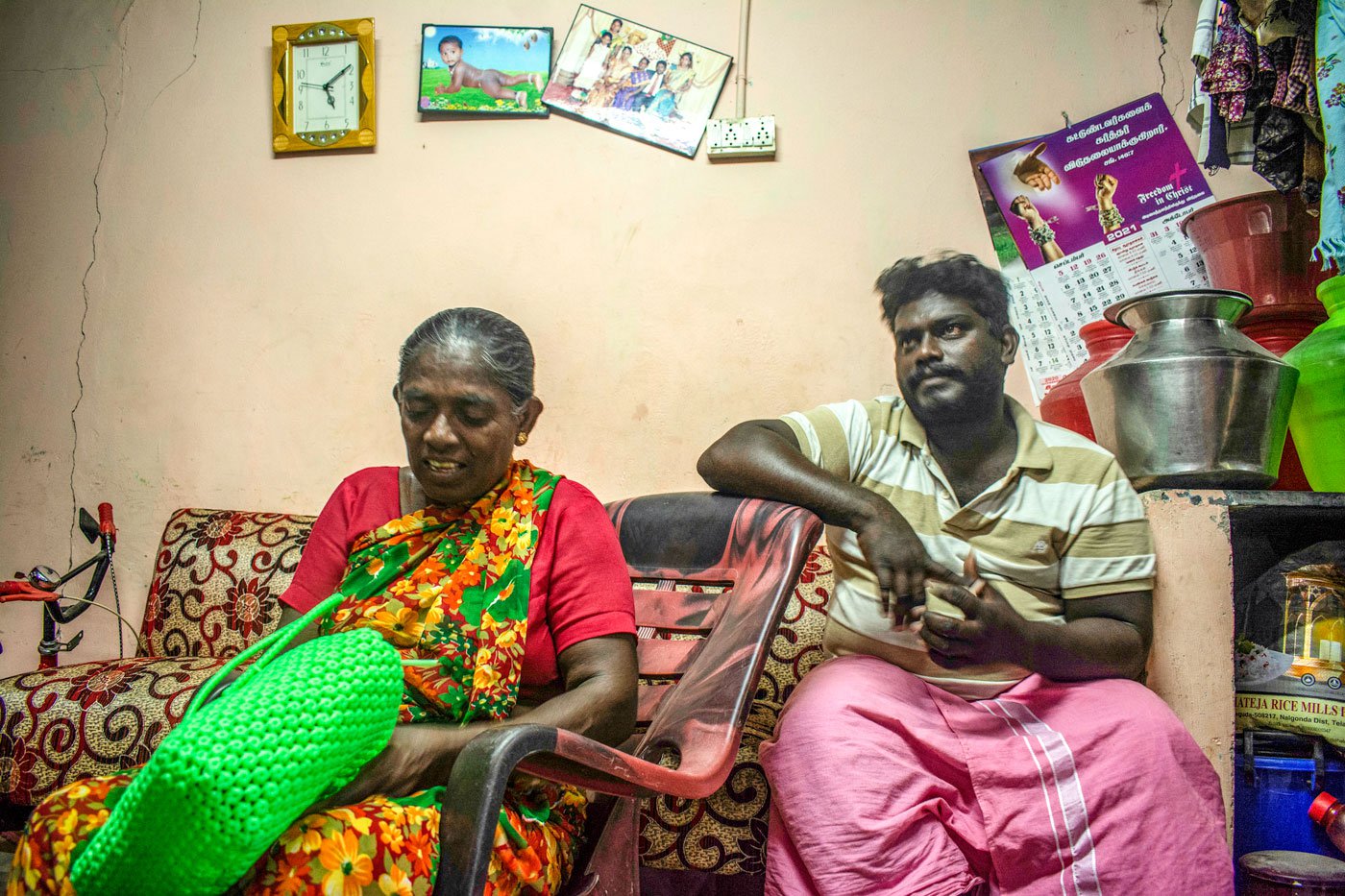
Rani at home, and with her son Kumar (right). During each pregnancy, she worked till the day of delivery – then walked to the hospital directly from the salt pans
*****
“Salt pans should be considered as agriculture, not as industry."
– G. Grahadurai, President, Thoothukudi, Small Scale Salt Manufacturers’ Association
In his airconditioned office in New Colony, Thoothukudi – not far, as the crow flies, from the scorching salt pans – G. Grahadurai gives me the big picture on the district’s salt industry. There are nearly 175 members in his Association, and each holds about 10 acres of land. Across the district, 25,000 acres of pans annually produce close to 25 lakh tons of salt.
On average, each acre makes 100 tons annually. In a bad year, with plenty of rain, that drops to 60. “Besides the sub-soil brine, we need electricity – to pump the water – and manual labour, to manufacture the salt,” says Grahadurai speaking of the escalating cost of labour. “It’s going up, up, up. Plus, the work hours are going down, from eight hours previously to just four hours now. They come at 5 a.m. and they’re gone by 9 a.m. Even if the owners go there, we can’t see any labourers.” The workers count the hours very differently from the way he does.
Grahadurai concedes the working conditions of salt pan labour are very hard. “Water and toilets need to be provided, but it’s not easy logistically, since the pans are situated across 100 kilometres.”
The market for Thoothukudi salt is shrinking, says Grahadurai. “Previously, this was known as the best edible salt anywhere. But now, it’s only going to the four southern states. And a little bit is exported to Singapore and Malaysia. Much of it is used in industries. Yes, some small revenue comes in from the gypsum scraped off the pans after the monsoon. But salt production is also increasingly affected by climate change, by rains in April and May.”
There is also stiff competition from Gujarat, “being hotter and drier than Thoothukudi, and 76 per cent of the country’s production now comes from that western state. Their salt holdings are very large, the manufacturing is partly mechanised and partly serviced by [poorly-paid] migrant workers from Bihar. Their pans are serviced by the tide waters, so they save on electricity costs too.”
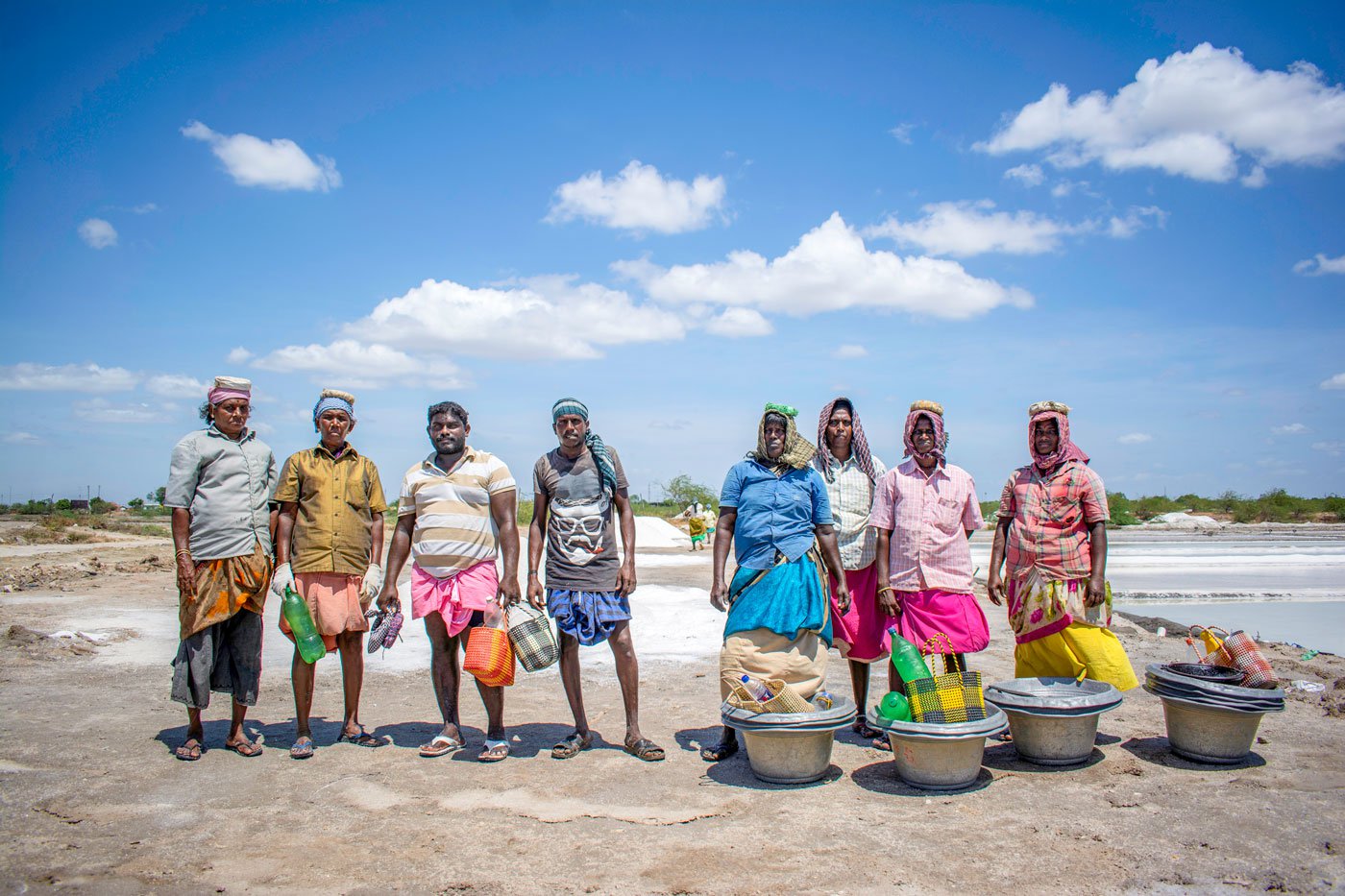
Little victories – small wage hikes and bonus – have all happened because the salt pan workers have fought for their rights
The production cost of a ton of salt in Thoothukudi is 600 to 700 rupees, “whereas in Gujarat it is only 300,” he claims. “How do we compete, especially when the price of a ton drops suddenly to 600 as it did in 2019?” To offset this, Grahadurai and others want salt manufacturing “to be considered as agriculture, not industry. [Hence the idea of salt as a ‘crop’.] Small salt manufacturers need soft interest loans, subsidised electricity and exemption from the Factories and Labour Acts.
“Already, this year, ships from Gujarat came and sold salt in Thoothukudi.”
*****
“They write about us only when something terrible happens.”
– Women salt pan workers
To strengthen the livelihoods of salt pan workers, Krishnamurthy of the Unorganised Workers Federation lays out several demands. Besides basic facilities – water, sanitation, resting area – he asks for the setting up of a committee with representatives of the workers, employers and government, to quickly resolve pending issues.
“We urgently need childcare facilities. As of now, anganwadis only function during office hours (9 to 5). Salt workers leave home at 5 a.m. and in some areas even before that. The oldest child – especially if she happens to be a girl – will then sit in for the mother, and her education is ruined. Shouldn’t anganwadis function from 5 a.m. to 10 a.m. to look after these children?”
Krishnamurthy explains that their little victories – small wage hikes and bonus – have all happened because the workers are united and fight for their rights. The 2021 Tamil Nadu budget of the new DMK government has fulfilled one long-standing demand: 5,000 rupees as relief during the monsoon. Krishnamurthy and social worker Uma Maheshwari acknowledge that the unorganised sector cannot easily become an organised one. The health problems are occupational hazards. But surely, they ask, “some basic social security measures can be made available?”
After all, the women workers point out, the employers always make a profit. Jhansi compares the salt pans with the palm trees – both hardy, capable of thriving under a relentless sun, and always useful. ‘Dhuddu’ , she says, using the slang for money, repeating it many times – the salt pans always give the owners money.
“But not us. Nobody knows about our lives,” the women tell me, drinking tea in tiny paper cups after work. “Everywhere you read about farmers, but the media only speak to us if we protest.” And, they argue, their voices sharp, irritated: “They write about us only when something terrible happens. Tell me, doesn’t everybody use salt?”
This research study is funded by Azim Premji University, Bengaluru, as part of their Research Funding Programme 2020.
